Functional Nanomaterials and Applications Lab
Table of contents (TOC) Publications
Reversible Modulation of Plasmonic Coupling of Gold Nanoparticles Confined within Swellable Polymer Colloidal Spheres
Angew. Chem. Int. Ed. 2024, asap doi: 10.1002/anie.202408020
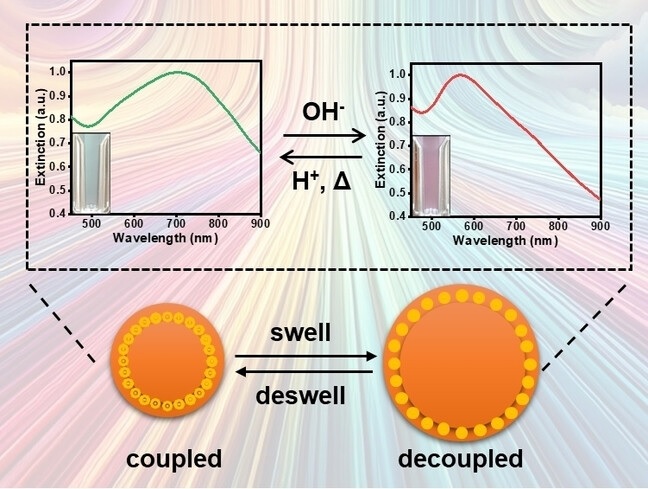
Abstract
Dynamic optical modulation in response to stimuli provides exciting opportunities for designing novel sensing,
actuating, and authentication devices. Here, we demonstrate that the reversible swelling and deswelling of crosslinked
polymer colloidal spheres in response to pH and temperature changes can be utilized to drive the assembly and disassembly
of the embedded gold nanoparticles (AuNPs), inducing their plasmonic coupling and decoupling and, correspondingly, color changes.
The multi-responsive colloids are created by depositing a monolayer of AuNPs on the surface of resorcinol-formaldehyde (RF)
nanospheres, then overcoating them with an additional RF layer, followed by a seeded growth process to enlarge the AuNPs and
reduce their interparticle separation to induce significant plasmonic coupling. This configuration facilitates dynamic
modulation of plasmonic coupling through the reversible swelling/deswelling of the polymer spheres in response to pH
and temperature changes. The rapid and repeatable transitions between coupled and decoupled plasmonic states of AuNPs
enable reversible color switching when the polymer spheres are in colloidal form or embedded in hydrogel substrates.
Furthermore, leveraging the photothermal effect and stimuli-responsive plasmonic coupling of the embedded AuNPs enables
the construction of hybrid hydrogel films featuring switchable anticounterfeiting patterns, showcasing the versatility
and potential of this multi-stimuli-responsive plasmonic system.
For citations:
Ye, Z.; Chen, C.; Cao, L.; Cai, Z.; Xu, C.; Kim, H.I; Giraldo, J. P.; Kanaras, A. G.; Yin, Y.
"Reversible Modulation of Plasmonic Coupling of Gold Nanoparticles Confined within Swellable Polymer Colloidal Spheres"
Angew. Chem. Int. Ed. 2024, asap doi: 10.1002/anie.202408020
Surfactin Conjugated Silver Nanoparticles as an Antibacterial and Antibiofilm Agent against Pseudomonas aeruginosa
ACS Appl. Mater. Interfaces 2023, 15 (37), 43321-43331

Abstract
The emergence of antimicrobial resistance is an alarming global health concern and has stimulated the development of novel functional
nanomaterials to combat Multidrug resistant (MDR) bacteria. In this work, we demonstrate for the first time the synthesis and application
of surfactin coated silver nanoparticles as an efficient antibacterial and antibiofilm agent against the drug resistant bacteria
Pseudomonas aeruginosa for safe dermal applications. Our in vivo studies showed no significant superficial dermal irritation,
edema and erythema whilst microscopic analysis revealed that surfactin coated silver nanoparticles caused no pathological
alterations at the applied concentrations. These results support the potential use of surfactin coated silver nanoparticles
against drug resistant bacterial, biofilm infections and in skin wound dressing applications.
For citations:
Rahman, L.; Sarwar, Y.; Khaliq, S.; Inayatullah, Abbas, W.; Mobeen, A.; Ullah, A.; Hussain, S. Z.; Khan, W. S.; Kyriazi, M. E.; Hussain, I.; Kanaras, A. G.; Rehman, A.
"Surfactin Conjugated Silver Nanoparticles as an Antibacterial and Antibiofilm Agent against Pseudomonas aeruginosa"
ACS Appl. Mater. Interfaces 2023, 15 (37), 43321-43331 DOI: 10.1021/acsami.3c07071
Single-cell RNA-sequence analysis of human bone marrow reveals new targets for isolation of skeletal stem cells using spherical nucleic acids
J. Tissue Eng. 2023, 14, 1-21
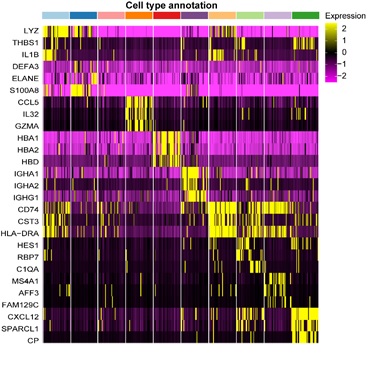
Abstract
There is a wealth of data indicating human bone marrow contains skeletal stem cells (SSC) with the capacity for
osteogenic, chondrogenic and adipogenic differentiation. However, current methods to isolate SSCs are restricted by
the lack of a defined marker, limiting understanding of SSC fate, immunophenotype, function and clinical application. The
current study applied single-cell RNA-sequencing to profile human adult bone marrow populations from 11 donors and
identified novel targets for SSC enrichment. Spherical nucleic acids were used to detect these mRNA targets in SSCs.
This methodology was able to rapidly isolate potential SSCs found at a frequency of <1 in 1,000,000 in human bone
marrow, with the capacity for tri-lineage differentiation in vitro and ectopic bone formation in vivo. The current studies
detail the development of a platform to advance SSC enrichment from human bone marrow, offering an invaluable
resource for further SSC characterisation, with significant therapeutic impact therein
For citations:
Matthews, E. Z.; Lanham, S.; White, K.; Kyriazi, M. E.; Alexaki, K.; El-Sagheer, A. H.; Brown, T.; Kanaras, A. G.; Wesy, J. J.; McArthur, B. D.; Stumpf, P. S.; Oreffo, R. O. C.
"Single-cell RNA-sequence analysis of human bone marrow reveals new targets for isolation of skeletal stem cells using spherical nucleic acids"
J. Tissue Eng. 2023, 14, 1-21 DOI: 10.1177/20417314231169375
Optical Mie Scattering by DNA-Assembled Three-Dimensional Gold Nanoparticle Superlattice Crystals
ACS Appl. Opt. Mater. 2023, 1(1), 69-77
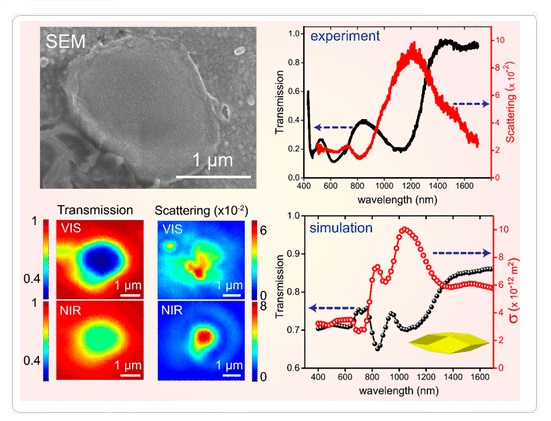
Abstract
Programmable assemblies of gold nanoparticles engineered with DNA have intriguing optical properties
such as Coulomb-interaction-driven strong coupling, polaritonic response in the visible range, and ultralow
dispersion dielectric response in the infrared spectral range. In this work, we demonstrate the optical
Mie resonances of individual microcrystals of DNA–gold nanoparticle superlattices. Broadband hyperspectral
mapping of both transmission and dark-field scattering reveal a polarization-insensitive optical response
with distinct spectral features in the visible and near-infrared ranges. Experimental observations are
supported by numerical simulations of the microcrystals under a resonant effective medium approximation
in the regime of capacitively coupled nanoparticles. The study identifies a universal characteristic
optical response which is defined by a band of multipolar Mie resonances, which only weakly depend
on the crystal size and light polarization. The use of gold superlattice microcrystals as scattering
materials is of interest for fields such as complex nanophotonics, thermoplasmonics, photocatalysis,
sensing, and nonlinear optics.
For citations:
Singh, H. J.; Misatziou, D.; Wheeler, C.; Buendia, A.; Giannini, V.; Sanchez-Gil, J. A.; Werts, M. H. V.; Brown, T.; El-Sagheer, A. H.; Kanaras,* A. G.; Muskens,* O. L.
"Optical Mie Scattering by DNA-Assembled Three-Dimensional Gold Nanoparticle Superlattice Crystals"
ACS Appl. Opt. Mater. 2023, 1(1), 69-77 doi: 10.1021/acsaom.2c00008
A SARS-Cov-2 sensor based on upconversion nanoparticles and graphene oxide
RSC Advances 2022, 12(29), 18445-18449
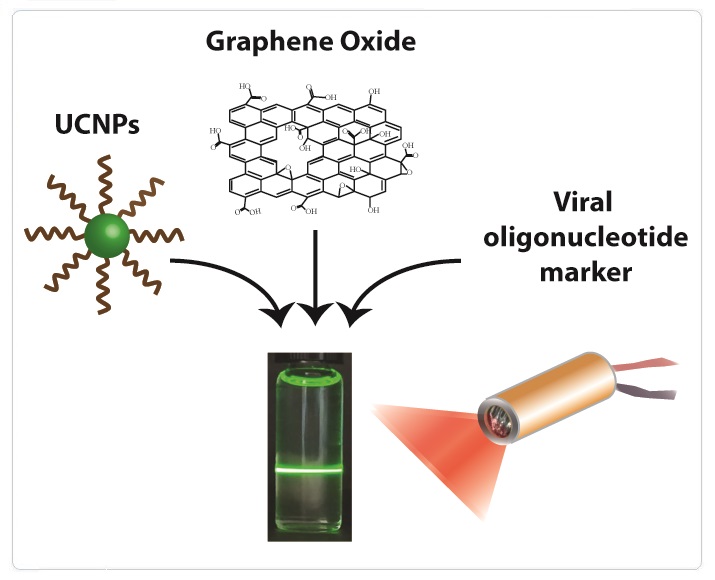
Abstract
Since the beginning of the COVID-19 pandemic, there has been an increased need
for the development of novel diagnostic solutions that can accurately and rapidly
detect SARS-CoV-2 infection. In this work, we demonstrate the targeting of viral
oligonucleotide markers within minutes without the requirement of a polymerase
chain reaction (PCR) amplification step via the use of oligonucleotide-coated
upconversion nanoparticles (UCNPs) and graphene oxide (GO).
For citations:
Alexaki, K.; Kyriazi, M. E.; Greening, J.; Taemaitree, L.; El-Sagheer, A. H.; Brown, T.; Zhang, X.; Muskens, O. L.; Kanaras,* A. G.
"A SARS-Cov-2 sensor based on upconversion nanoparticles and graphene oxide"
RSC Advances 2022, 12(29), 18445-18449 doi: 10.1039/D2RA03599E
Nanoparticle-Induced Property Changes in Nematic Liquid Crystals
Nanomaterials 2022, 12(3), 341
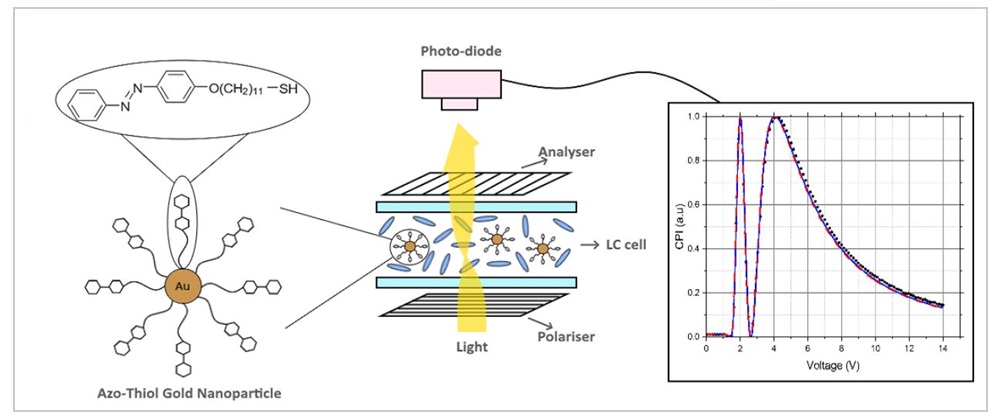
Abstract
Doping liquid crystals with nanoparticles is a widely accepted method to enhance
liquid crystal’s intrinsic properties. In this study, a quick and reliable method to
characterise such colloidal suspensions using an optical multi-parameter analyser, a
cross-polarised intensity measurement-based device, is presented. Suspensions characterised
in this work are either plasmonic (azo-thiol gold AzoGNPs) or ferroelectric Sn2P2S6 (SPS)
nanoparticles in nematic liquid crystals. The elastic constants and rotational viscosity
showed nonlinear dependence on the concentration of AzoGNPs, initially increasing at
lower concentrations and then decreasing at higher concentrations, indicating some degree
of particle aggregation. For the SPS suspension, the elastic constant decreased with
doping, while the rotational viscosity increased, in agreement with previous findings.
Through viscosity measurements, the stability of SPS suspension over ten years is
also highlighted.
For citations:
Brouckaert, N.; Podoliak, N.; Orlova, T.; Bankova, D.; De Fazio, A. F. ; Kanaras, A. G.; Hovorka, O.; D'Alessandro, G.; Kaczmarek, M.
"Nanoparticle-Induced Property Changes in Nematic Liquid Crystals"
Nanomaterials 2022, 12(3), 341 doi:10.3390/nano12030341
An investigation into the resistance of spherical nucleic acids against DNA enzymatic degradation
Bioconjugate Chemistry 2022, 33(1) 219–225
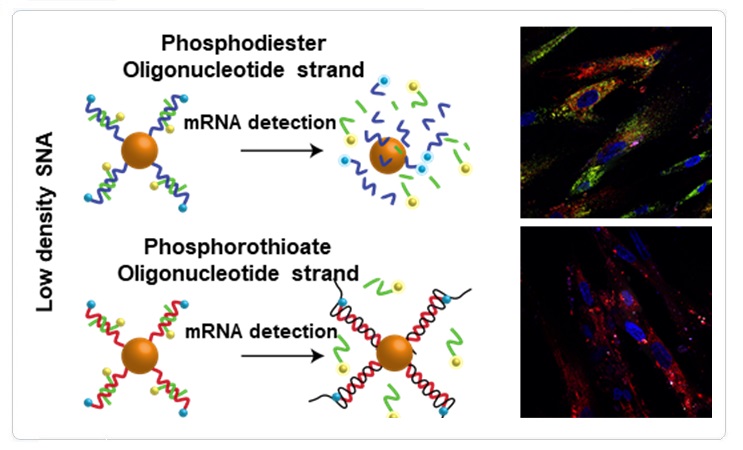
Abstract
Nanoparticles coated with oligonucleotides, also termed spherical nucleic acids (SNAs),
are at the forefront of scientific research and have been applied in vitro and in vivo for
sensing, gene regulation, and drug delivery. They demonstrate unique properties stemming
from the three-dimensional shell of oligonucleotides and present high cellular uptake.
However, their resistance to enzymatic degradation is highly dependent on their
physicochemical characteristics. In particular the oligonucleotide loading of SNAs
has been determined to be a critical parameter in SNA design. In order to ensure the
successful function of SNAs, the degree of oligonucleotide loading has to be
quantitatively determined to confirm that a dense oligonucleotide shell has been
achieved. However, this can be time consuming and may lead to multiple synthesis
being required to achieve the necessary degree of surface functionalization. In
this work we show how this limitation can be overcome by introducing an
oligonucleotide modification. By replacing the phosphodiester bond on the
oligonucleotide backbone with a phosphorothioate bond, SNAs even with a low
DNA loading showed remarkable stability in the presence of nucleases. Furthermore,
these chemically modified SNAs, exhibited high selectivity and specificity
towards the detection of mRNA in cellulo.
For citations:
Kyriazi, M.E.; El-Sagheer, A. H.; Medintz, I.; Brown, T.; Kanaras,* A. G.
"An investigation into the resistance of spherical nucleic acids against DNA enzymatic degradation "
Bioconjugate Chemistry 2022, 33(1) 219–225 doi:10.1021/acs.bioconjchem.1c00540.
Chemically modified nucleic acids and DNA intercalators as tools for nanoparticle assembly
Chem.Soc.Rev. 2021, 50 (23), 13410-13440 doi: 10.1039/D1CS00632K
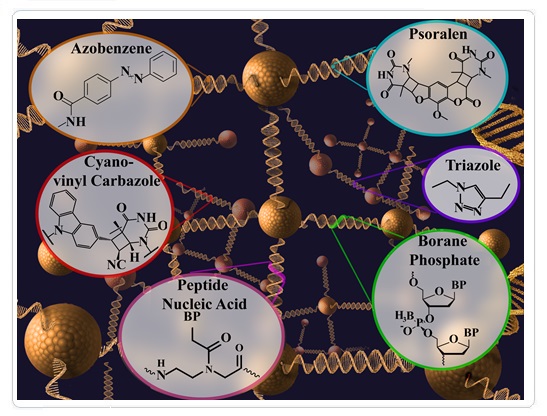
Abstract
The self-assembly of inorganic nanoparticles to larger structures is of great research interest
as it allows the fabrication of novel materials with collective properties correlated to the nanoparticles’
individual characteristics. Recently developed methods for controlling nanoparticle organisation have
enabled the fabrication of a range of new materials. Amongst these, the assembly of nanoparticles using
DNA has attracted significant attention due to the highly selective recognition between complementary
DNA strands, DNA nanostructure versatility, and ease of DNA chemical modification. In this review we
discuss the application of various chemical DNA modifications and molecular intercalators as tools for
the manipulation of DNA-nanoparticle structures. In detail, we discuss how DNA modifications and small
molecule intercalators have been employed in the chemical and photochemical DNA ligation in nanostructures;
DNA rotaxanes and catenanes associated with reconfigurable nanoparticle assemblies; and DNA backbone
modifications including locked nucleic acids, peptide nucleic acids and borane nucleic acids, which
affect the stability of nanostructures in complex environments. We conclude by highlighting the
importance of maximising the synergy between the communities of DNA chemistry and nanoparticle
self-assembly with the aim to enrich the library of tools available for the manipulation
of nanostructures.
For citations:
De Fazio, A. F; Misatziou, D.; Baker, Y.; Muskens. O. L.; Brown, T.; Kanaras,* A. G.
"Chemically modified nucleic acids and DNA intercalators as tools for nanoparticle assembly "
Chem. Soc. Rev. 2021, 50 (23), 13410-13440 doi: 10.1039/D0NA00858C
A method for the growth of uniform silica shells on different size and morphology upconversion nanoparticles
Nanoscale Adv. 2021, 3 (12), 3522-3529 doi: 10.1039/D0NA00858C
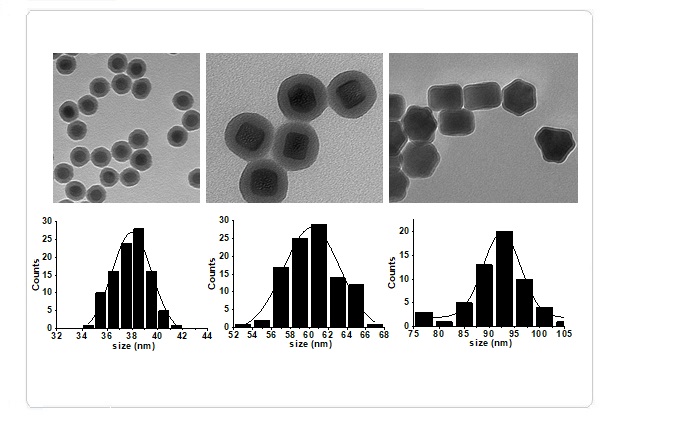
Abstract
Lanthanide-doped upconversion nanoparticles have emerged as attractive candidates for biomedical applications.
This is due to their excitation and emission wavelengths, which lay the foundation for deeper penetration depth
into biological tissue, higher resolution due to reduced scattering and improved imaging contrast as a result of
a decrease in autofluorescence background. Usually, their encapsulation within a biocompatible silica shell is
a requirement for their dispersion within complex media or for further functionalization of the upconversion
nanoparticle surface. However, the creation of a silica shell around upconversion nanoparticles can be often
challenging, many times resulting in partial silica coating or nanoparticle aggregation, as well as the production
of a large number of silica particles as a side product. In this work we demonstrate a method to accurately
predict the experimental conditions required to form a high yield of silica-coated upconversion nanoparticles,
regardless of their shape and size.
For citations:
Ureña-Horno, E. Kyriazi, M.E.; Kanaras,* A. G.
"A method for the growth of uniform silica shells on different size and morphology upconversion nanoparticles "
Nanoscale Adv. 2021, 3 (12), 3522-3529 doi: 10.1039/D0NA00858C
DNA Gold Nanoparticle Motors Demonstrate Processive Motion with Bursts of Speed Up to 50 nm Per Second
ACS Nano 2021, 15 (5), 8427–8438 doi: 10.1021/acsnano.0c10683

Abstract
Synthetic motors that consume chemical energy to produce mechanical work offer potential
applications in many fields that span from computing to drug delivery and diagnostics. Among
the various synthetic motors studied thus far, DNA-based machines offer the greatest programmability
and have shown the ability to translocate micrometer-distances in an autonomous manner.
DNA motors move by employing a burnt-bridge Brownian ratchet mechanism, where the DNA “legs”
hybridize and then destroy complementary nucleic acids immobilized on a surface. We have
previously shown that highly multivalent DNA motors that roll offer improved performance
compared to bipedal walkers. Here, we use DNA-gold nanoparticle conjugates to investigate
and enhance DNA nanomotor performance. Specifically, we tune structural parameters such as
DNA leg density, leg span, and nanoparticle anisotropy as well as buffer conditions to
enhance motor performance. Both modeling and experiments demonstrate that increasing DNA
leg density boosts the speed and processivity of motors, whereas DNA leg span increases
processivity and directionality. By taking advantage of label-free imaging of nanomotors,
we also uncover Lévy-type motion where motors exhibit bursts of translocation that are
punctuated with transient stalling. Dimerized particles also demonstrate more ballistic
trajectories confirming a rolling mechanism. Our work shows the fundamental properties
that control DNA motor performance and demonstrates optimized motors that can travel multiple
micrometers within minutes with speeds of up to 50 nm/s. The performance of these nanoscale
motors approaches that of motor proteins that travel at speeds of 100–1000 nm/s, and hence
this work can be important in developing protocellular systems as well next generation
sensors and diagnostics.
For citations:
Bazrafsan, A.; Kyriazi, M. E; Alexander Holt, B.; Deng, W.; Piranej, S.; Su, H.; Hu, Y.; El-Sagheer, A. H.; Brown, T.; Kwong, G. A.; Kanaras, A. G.; Salaita, K.
"DNA Gold Nanoparticle Motors Demonstrate Processive Motion with Bursts of Speed Up to 50 nm Per Second"
ACS Nano 2021, 15 (5), 8427–8438 doi: 10.1021/acsnano.0c10683
Exciton effects in perovskite nanocrystals
J. Phys. Photonics, 2021,3(2),021002 doi: 10.1088/2515-7647/abedd0
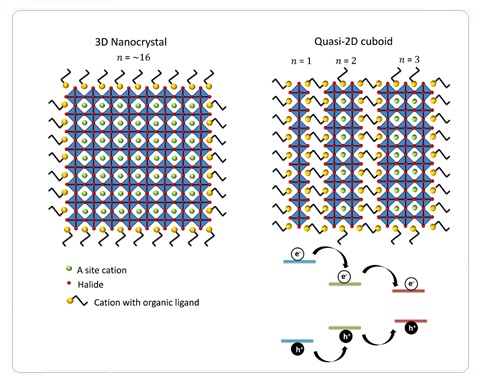
Abstract
Nanocrystals (NCs) of perovskite materials have recently attracted great research interest because
of their outstanding properties for optoelectronic applications, as evidenced by the increasing number
of publications on laboratory scale devices. However, in order to achieve the commercial realisation
of these devices, an in-depth understanding of the charge dynamics and photo-physics in these novel
materials is required. These dynamics are affected by material composition but also by their size
and morphology due to quantum confinement effects. Advances in synthesis methods have allowed
nanostructures to be produced with enhanced confinement and structural stability, enhancing the
efficiency of energy funnelling and radiative recombination and so resulting in more efficient
light emitting devices. In addition, photovoltaics could greatly benefit from the exploitation
of these materials not only through their deployment in tandem cell architectures but from the
use of multiple exciton generation in these NCs. These systems also offer the opportunity to
study quantum effects relating to interactions of excited states within and between NCs.
Properties and behaviour that includes an enhanced Rashba effect, superfluorescence, polariton
lasing, Rydberg exciton polariton condensates, and antibunched single photon emission have been
observed in a single metal halide perovskite NC. The furtherstudy of these in NC systems will
shed new light on the fundamental nature of their excited states, their control and exploitation.
In this perspective, we give an overview of these effects and provide an outlook for the future
of perovskite NCs and their devices.
For citations:
Ahumada-Lazo, R.; Saran, R.; Woolland, O.; Jia, Y.; Kyriazi, M.E.; Kanaras, A. G.; Binks, D.; Curry, R. J.
"Exciton effects in perovskite nanocrystals"
J. Phys. Photonics, 2021,3(2),021002 doi: 10.1088/2515-7647/abedd0
Enrichment of Skeletal Stem Cells from Human Bone Marrow Using Spherical Nucleic Acids
ACS Nano 2021, 15 (4), 6909-6916 doi: 10.1021/acsnano.0c10683
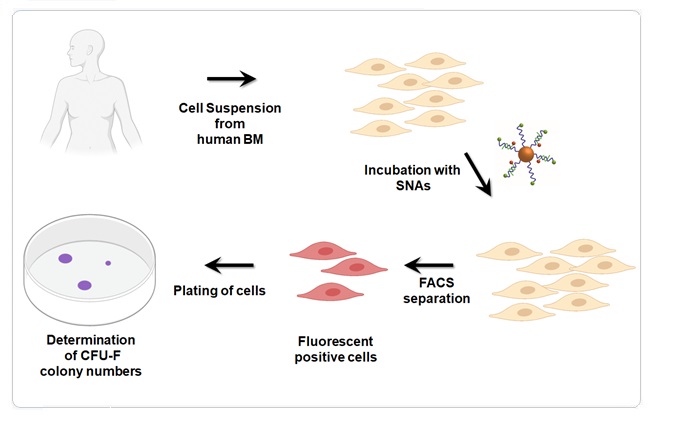
Abstract
Human bone marrow (BM) derived stromal cells contain a population of skeletal stem cells (SSCs),
with the capacity to differentiate along the osteogenic, adipogenic and chondrogenic lineages enabling
their application to clinical therapies. However, current methods, to isolate and enrich SSCs from
human tissues remain, at best, challenging in the absence of a specific SSC marker. Unfortunately,
none of the current proposed markers, alone, can isolate a homogenous cell population with the ability
to form bone, cartilage, and adipose tissue in humans. Here, we have designed DNA-gold nanoparticles
able to identify and sort SSCs displaying specific mRNA signatures. The current approach demonstrates
the significant enrichment attained in the isolation of SSCs, with potential therein to enhance our
understanding of bone cell biology and translational applications.
For citations:
Xavier, M.; Kyriazi, M. E; Lanham, S.; Alexaki, K.; Matthews, E.; El-Sagheer, A. H.; Brown, T.; Kanaras,* A. G.; Oreffo*, R. O. C
"Enrichment of Skeletal Stem Cells from Human Bone Marrow Using Spherical Nucleic Acids"
ACS Nano 2021, 15 (4), 6909-6916 doi: 10.1021/acsnano.0c10683
A DNA Sensor Based on Upconversion Nanoparticles and Two-Dimensional Dichalcogenide Materials
Front. Chem. Sci. Eng. 2021, 15(4), 935-943 doi: 10.1007/s11705-020-2023-9
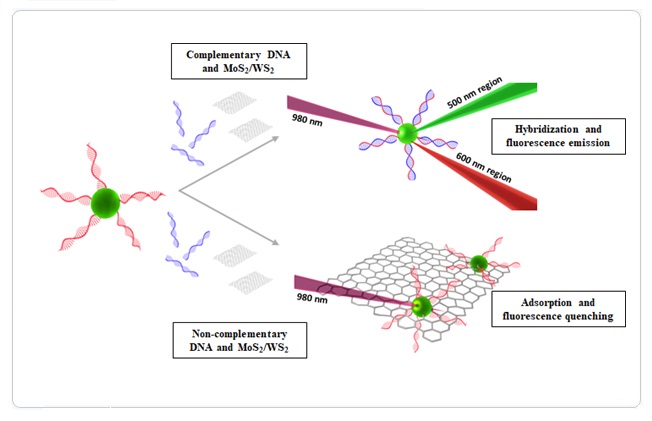
Abstract
We demonstrate the fabrication of a new DNA sensor that is based on the optical interactions
occurring between oligonucleotide-coated NaYF4:Yb3+;Er3+ upconversion nanoparticles and the
two-dimensional dichalcogenide materials, MoS2 and WS2. Monodisperse upconversion nanoparticles
were functionalized with single-stranded DNA endowing the nanoparticles with the ability to
interact with the surface of the two-dimensional materials via van der Waals interactions leading
to subsequent quenching of the upconversion fluorescence. By contrast, in the presence of a
complementary oligonucleotide target and the formation of double-stranded DNA, the upconversion
nanoparticles could not interact with MoS2 and WS2, thus retaining their inherent fluorescence
properties. Utilizing this sensor we were able to detect target oligonucleotides with high sensitivity
and specificity whilst reaching a concentration detection limit as low as 5 mol·L-1, within minutes.
For citations:
Alexaki, K.; Giust, D.; Kyriazi, M. E; El-Sagheer, A. H.; Brown, T.; Muskens, O. L.; Kanaras,* A. G.
"A DNA Sensor Based on Upconversion Nanoparticles and Two-Dimensional Dichalcogenide Materials"
Front. Chem. Sci. Eng. 2021, 15(4), 935-943 doi: 10.1007/s11705-020-2023-9
Nanoparticles-assisted delivery of antiviral-siRNA as inhalable treatment for human respiratory viruses: A candidate approach against SARS-COV-2
NanoSelect 2020, 1(6), 612-621 doi:10.1002/nano.202000125
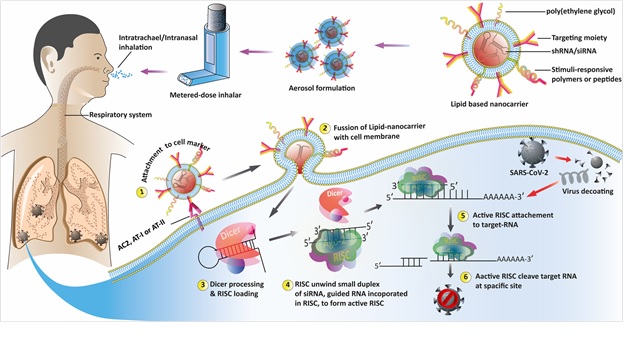
Abstract
The current pandemic of coronavirus disease 2019 (COVID-19) caused by severe acute respiratory syndrome
coronavirus-2 (SARS-CoV-2) has challenged healthcare structures across the globe. Although a few
therapies are approved by FDA, the search for better treatment options is continuously on rise. Clinical
management includes infection prevention and supportive care such as supplemental oxygen and mechanical
ventilatory support. Given the urgent nature of the pandemic and the number of companies and researchers
developing COVID-19 related therapies, FDA has created an emergency program to move potential treatments
with already approved drugs to patients as quickly as possible in parallel to the development of new drugs
that must first pass the clinical trials. In this manuscript, we have reviewed the available literature
on the use of sequence-specific degradation of viral genome using short-interfering RNA (siRNA) suggesting
it as a possible treatment against SARS-CoV-2. Delivery of siRNA can be promoted by the use of FDA approved
lipids, polymers or lipid-polymer hybrids. These nanoparticulate systems can be engineered to exhibit
increased targetability and formulated as inhalable aerosols.
For citations:
Ullah, A.; Qazi, J.; Rahman, L.; Kanaras, A. G.; Khan, W. S.; Hussain, I. Rehman, A.
"Nanoparticles-assisted delivery of antiviral-siRNA as inhalable treatment for human respiratory viruses: A candidate approach against SARS-COV-2"
NanoSelect 2020, 2020, 1(6), 612-621 doi:10.1002/nano.202000125
Bactericidal Effect of 5-Mercapto-2-nitrobenzoic Acid-Coated Silver Nanoclusters against Multidrug-Resistant Neisseria gonorrhoeae
ACS Appl. Mater. Interfaces 2020, 12(25), 27994–28003 doi:10.1021/acsami.0c06163
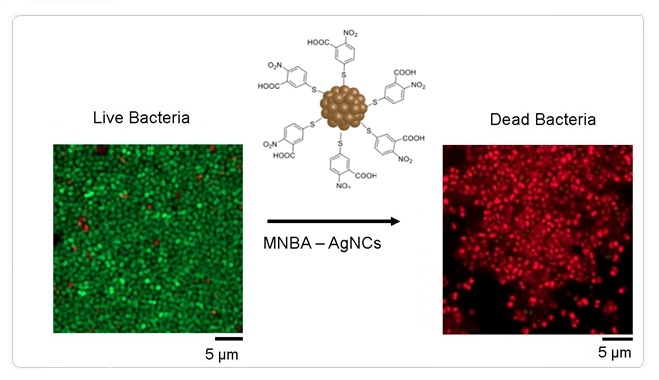
Abstract
Neisseria gonorrhoeae is among the most multidrug-resistant bacteria in circulation today,
and new treatments are urgently needed. In this work, we demonstrate the ability of
5-mercapto-2-nitrobenzoic acid-coated silver nanoclusters (MNBA-AgNCs) to kill
strains of Neisseria gonorrhoeae. Using an in vitro bactericidal assay,
MNBA-AgNCs had been found to show significantly higher anti-gonococcal bioactivity
than the antibiotics ceftriaxone and azithromycin and silver nitrate.
These nanoclusters were effective against both planktonic bacteria and a gonococcal
infection of human cell cultures in vitro. Treatment of human cells in vitro with
MNBA-AgNCs did not induce significant release of lactate dehydrogenase, suggesting
minimal cytotoxicity to eukaryotic cells. Our results suggest that MNBA-AgNCs hold
great potential for topical treatment of localized gonorrhoeae.
For citations:
Lucio, M. I.; Kyriazi, M.E.; Hamilton, J.; Batista, D.; Sheppard, A.; Sams-Dodd, E.; Humbert, M. V.; Hussain, I.; Christodoulides,* M.; Kanaras,* A. G.
"Bactericidal Effect of 5-Mercapto-2-nitrobenzoic Acid-Coated Silver Nanoclusters against Multidrug-Resistant Neisseria gonorrhoeae"
ACS Appl. Mater. Interfaces 2020, 12(25), 27994–28003 doi:10.1021/acsami.0c06163
Light-Induced Reversible DNA Ligation of Gold Nanoparticle Superlattices
ACS Nano 2019, 13(5),5771-5777 doi:10.1021/acsnano.9b01294
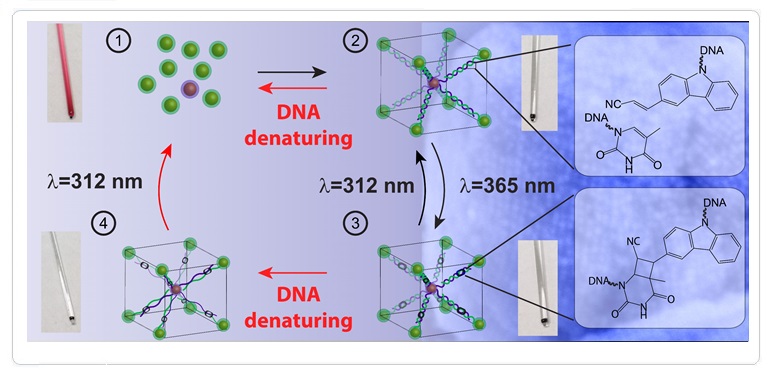
Abstract
DNA-mediated self-assembly of nanoparticles has been of great interest because
it enables access to nanoparticle superstructures that cannot be synthesized otherwise.
However, the programmability of higher order nanoparticle structures can be easily
lost under DNA denaturing conditions. Here, we demonstrate that light can be
employed as an external stimulus to master the stability of nanoparticle
superlattices (SLs) via the promotion of a reversible photoligation of DNA in SLs.
The oligonucleotides attached to the nanoparticles are encoded to ligate using
365 nm light, effectively locking the SLs and rendering them stable under DNA
denaturing conditions. The reversible process of unlocking these structures is
possible by irradiation with light at 315 nm, recovering the structures to their
natural state. Our work inspires a new research direction towards post-assembly
manipulation of nanoparticle superstructures using external stimuli as a tool
to enrich the library of new material forms and their application in different
media and environments
For citations:
De Fazio, A. F.; El-Sagheer, A. H.; Kahn, J. S.; Nandhakumar, I.; Burton, M. R.; Brown, T.; Muskens, O. L.; Gang,* O.; Kanaras,* A. G.
"Light-Induced Reversible DNA Ligation of Gold Nanoparticle Superlattices "
ACS Nano 2019,13(5),5771-5777 doi:10.1021/acsnano.9b01294
The Role of Ligands in the Chemical Synthesis and Applications of Inorganic Nanoparticles
Chemical Reviews 2019,119(8),4819-4880 doi:10.1021/acs.chemrev.8b00733
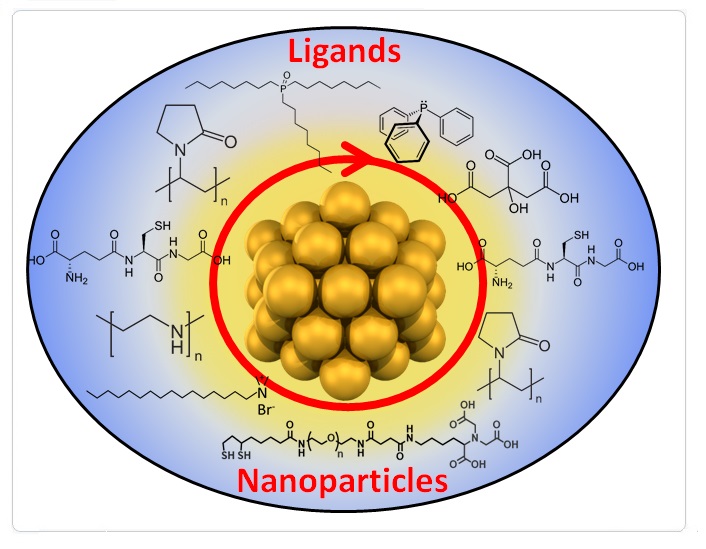
Abstract
The design of nanoparticles is critical for their efficient use in many applications
ranging from biomedicine to sensing and energy. While shape and size are responsible for
the properties of the inorganic nanoparticle core, the choice of ligands is of utmost
importance for the colloidal stability and function of the nanoparticles. Moreover,
the selection of ligands employed in nanoparticle synthesis can determine their final
size and shape. Ligands added after nanoparticle synthesis infer both new properties
as well as provide enhanced colloidal stability. In this article, we provide a
comprehensive review on the role of the ligands with respect to the nanoparticle morphology,
stability, and function. We analyze the interaction of nanoparticle surface and ligands
with different chemical groups, the types of bonding, the final dispersibility of
ligand-coated nanoparticles in complex media, their reactivity, and their performance
in biomedicine, photodetectors, photovoltaic devices, light-emitting devices, sensors,
memory devices, thermoelectric applications, and catalysis.
For citations:
Heuer-Jungemann, A.; Feliu, N.; Bakaimi, I.; Hamaly, M.; Alkilany, A.; Chakraborty, I.; Masood, A.; Casula, M. F.; Kostopoulou, A.;
Oh?, E.; Susumu?, K.; Stewart, M. H.; Medintz, I. L.; Stratakis, E.; Parak, W. J.; Kanaras,* A. G.
"The Role of Ligands in the Chemical Synthesis and Applications of Inorganic Nanoparticles"
Chemical Reviews 2019,119(8),4819-4880 doi:10.1021/acs.chemrev.8b00733
DNA-Coated Gold Nanoparticles for the Detection of mRNA in Live Hydra Vulgaris Animals
ACS Applied Materials & Interfaces 2019,11(15),13905-13911 doi: 10.1021/acsami.8b17846
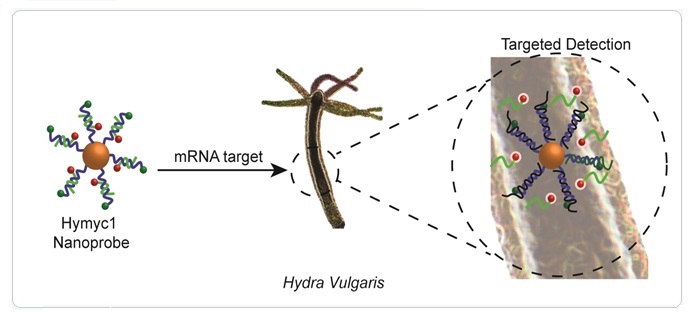
Abstract
Advances in nanoparticle design have led to the development of nanoparticulate systems that
can sense intracellular molecules, alter cellular processes, and release drugs to specific targets
in vitro. In this work, we demonstrate that oligonucleotide-coated gold nanoparticles are suitable
for the detection of mRNA in live Hydra vulgaris, a model organism, without affecting the animal’s
integrity. We specifically focus on the detection of Hymyc1 mRNA, which is responsible for the
regulation of the balance between stem cell self-renewal and differentiation. Myc deregulation
is found in more than half of human cancers, thus the ability to detect in vivo related mRNAs
through innovative fluorescent systems is of outmost interest.
For citations:
Moros, M.; Kyriazi, M. E., El-Sagheer, A. H.; Brown, T.; Tortiglione,* C.; Kanaras,* A. G.
"DNA-Coated Gold Nanoparticles for the Detection of mRNA in Live Hydra Vulgaris Animals "
Appl. Mater. Interfaces 2019,11(15),13905-13911 doi:10.1021/acsami.8b17846
Biosurfactant coated silver and iron oxide nanoparticles with enhanced anti-biofilm and anti-adhesive properties
Journal of Hazardous Materials 2019, 364, 441-448 doi: 10.1016/j.jhazmat.2018.10.049
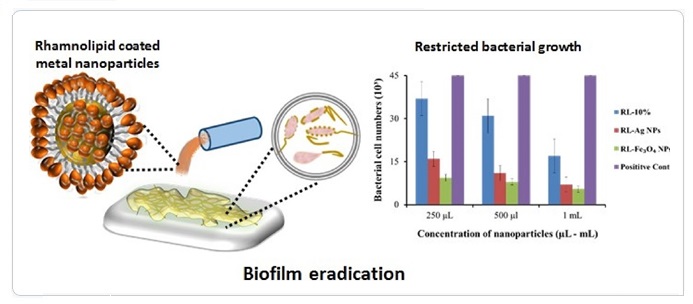
Abstract
Pseudomonas aeruginosa and Staphylococcus aureus are among the hazardous biofilm forming bacteria
ubiquitous in industrial/clinical wastes. Serious efforts are required to develop effective strategies
to control surface-growing antibiotic resistant pathogenic bacterial communities which they are
emerging as a global health issue. Blocking hazardous biofilms would be a useful aspect of biosurfactant
coated nanoparticles (NPs). In this regard, we report a facile method for the synthesis of
rhamnolipid (RL) coated silver (Ag) and iron oxide (Fe3O4) NPs and propose the mechanism of
their synergistic antibacterial and anti-adhesive properties against biofilms formed by P. aeruginosa
and S. aureus. These NPs demonstrated excellent anti-biofilm activity not only during the biofilms
formation but also on the pre-formed biofilms. Mechanistically, RL coated silver (35?nm) and Fe3O4 NPs (48?nm)
generate reactive oxygen species, which contribute to the antimicrobial activity. The presence of
RLs shell on the nanoparticles significantly reduces the cell adhesion by modifying the surface
hydrophobicity and hence enhancing the anti-biofilm property of NPs against both mentioned strains.
These findings suggest that RL coated Ag and Fe3O4 NPs may be used as potent alternate to reduce
the infection severity by inhibiting the biofilm formation and, therefore, they possess potential
biomedical applications for antibacterial coatings and wound dressings.
For citations:
Khalid, H. F.; Tehseen, B., Sarwar, Y.; Hussain, S. Z.; Khan, W. S.; Raza, Z. A.; Bajwa, S. Z.; Kanaras, A. G.; Hussain, I.; Rehman, A.
"Biosurfactant coated silver and iron oxide nanoparticles with enhanced anti-biofilm and anti-adhesive properties"
J. Hazard. Mater. 2019, 364, 441-448 doi: 10.1016/j.jhazmat.2018.10.049
Anion exchange in inorganic perovskite nanocrystal polymer composites
Chemical Science 2018, 9 (42), 8121-8126 doi: 10.1039/c8sc02830c
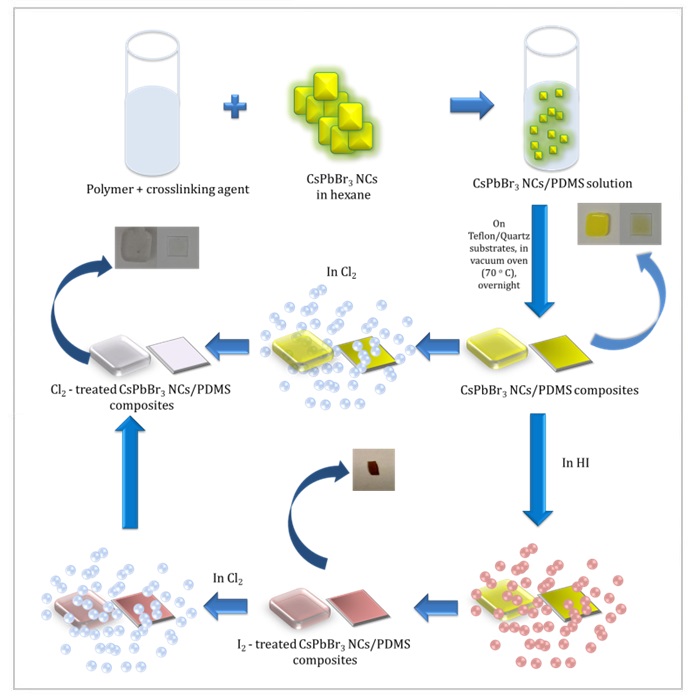
Abstract
We demonstrate a facile, low-cost and room-temperature method of anion exchange in cesium lead
bromide nanocrystals (CsPbBr3 NCs), embedded into a polymer matrix. The anion exchange occurs
upon exposure of the solid CsPbBr3 NCs/PDMS nanocomposite to a controlled anion precursor gas
atmosphere. The rate and extent of the anion exchange reaction can be controlled via the variation of
either the exposure time or the relative concentration of the anion precursor gas. Post-synthesis
chemical transformation of perovskite nanocrystal–polymer composites is not readily achievable using
conventional methods of anion exchange, which renders the gas-assisted strategy extremely useful. We
envisage that this work will enable the development of solid-state perovskite NC optoelectronic devices.
For citations:
Sygletou, Kyriazi, M. E.;Kanaras, A. G.; Stratakis, E.
"Anion exchange in inorganic perovskite nanocrystal polymer composites"
Chem. Sci. 2018, 9 (42), 8121-8126 doi: 10.1039/c8sc02830c
In-Depth Analysis of Excitation Dynamics in Dye-Sensitized Upconversion Core and Core/Active Shell Nanoparticles
Journal of Physical Chemistry C 2018, 122(31) 18177-18184
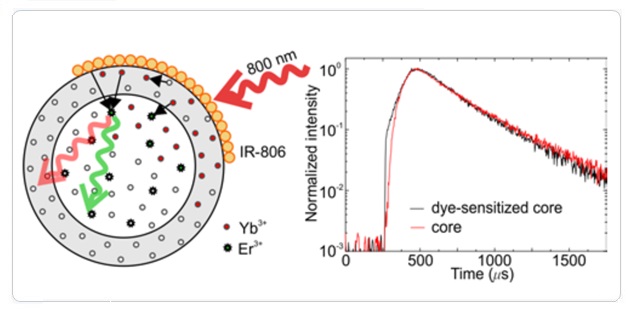
Abstract
Upconversion nanoparticles (UCNPs) combining both dye sensitization and core/shell enhancement are of great
interest for their ability to boost the excitation efficiency of upconversion systems. Here, we report and investigate
a 20-fold upconversion luminescence enhancement in dye-sensitized core/active shell UCNPs compared to non-sensitized
core-only UCNPs. We observe a two-component luminescence rise dynamics in the upconversion kinetics of dye-sensitized
UCNPs, distinctly different from the one-component rise dynamics of the non-sensitized UCNPs. For dye-sensitized UCNPs,
the fast, sub-microsecond component of the upconversion luminescence rise time is attributed to radiative pumping of
Er3+ ions from the dye, while the slow, sub-millisecond component is due to non-radiative energy transfer from the dye
predominantly to Yb3+ ions, followed by energy migration and non-radiative energy transfer from Yb3+ to Er3+ ions.
Our studies provide an insight to the interplay between radiative and non-radiative energy transfer as well as in the
role of energy migration across the active shell of dye-sensitized core/active shell UCNPs.
For citations:
Alyatkin, S.; Urena Horno, E.; Chen, B.; Muskens, O. L.; Kanaras, A. G.; Lagoudakis, P. G.
"In-Depth Analysis of Excitation Dynamics in Dye-Sensitized Upconversion Core and Core/Active Shell Nanoparticles"
J. Phys. Chem. C 2018, 122(31) 18177-18184
Colloidal Synthesis of CsX Nanocrystals (X= Cl, Br, I).
Nanomaterials 2018, 8, 506
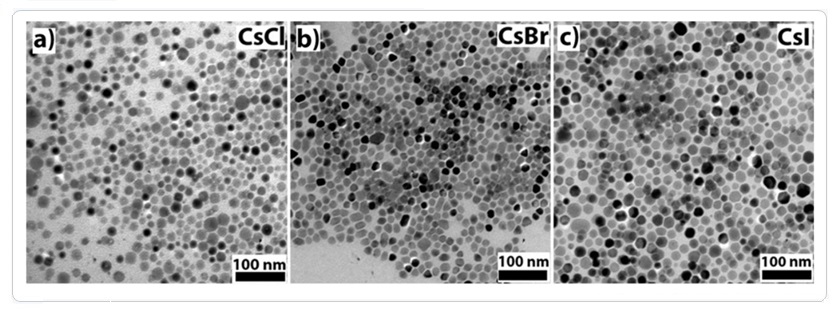
Abstract
A facile colloidal synthesis of highly ionic cesium halide nanocrystals is reported.
Colloidal nanocrystals of CsI, CsCl and CsBr with unprecedentedly small dimensions are
obtained using oleylammonium halides and cesium oleate as precursors. The ease and adaptability
of our method enables its universalization for the formation of other highly ionic nanocrystals.
For citations:
Shaw, P. J.; Meyns, M.; Zuo, Y.; Grau-Carbonell, A.; Lagoudakis, P. G.; Charlton, M. D. B.; Martí-Sánchez, S.; Arbiol, J.; Cabot,* A. Kanaras,* A. G.
"Colloidal Synthesis of CsX Nanocrystals (X= Cl, Br, I)"
Nanomaterials 2018, 8, 506 DOI:doi:10.3390/nano8070506
Graphene Oxide–Upconversion Nanoparticle Based Portable Sensors for Assessing Nutritional Deficiencies in Crops.
ACS Nano 2018, 12 (6), pp 6273–6279
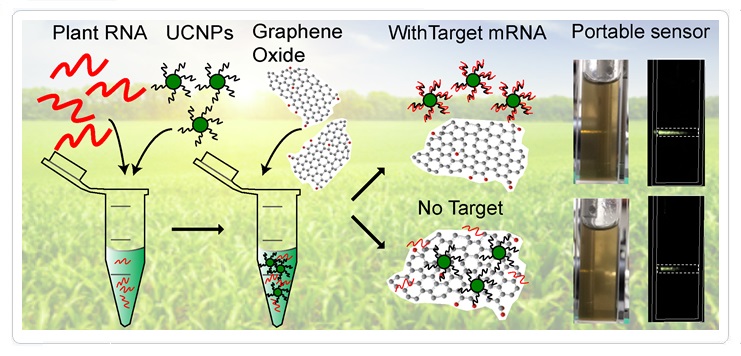
Abstract
The development of innovative technologies to rapidly detect biomarkers
associated with nutritional deficiencies in crops is highly relevant to agriculture
and thus could impact the future of food security. Zinc (Zn) is an important
micronutrient in plants, and deficiency leads to poor health, quality, and yield
of crops. We have developed portable sensors, based on graphene oxide and
upconversion nanoparticles, which could be used in the early detection of
Zn deficiency in crops, sensing mRNAs encoding members of the ZIP-transporter
family in crops. ZIPs are membrane transport proteins, some of which are up-regulated
at the early stages of Zn deficiency, and they are part of the biological mechanism
by which crops respond to nutritional deficiency. The principle of these sensors
is based on the intensity of the optical output resulting from the interaction
of oligonucleotide-coated upconversion nanoparticles and graphene oxide in the
absence or presence of a specific oligonucleotide target. The sensors can
reliably detect mRNAs in RNA extracts from plants using a smartphone camera.
Our work introduces the development of accurate and highly sensitive sensors
for use in the field to determine crop nutrient status and ultimately facilitate
economically important nutrient management decisions.
For citations:
Giust, D.; Lucio, M. I.; El-Sagheer, A. H.; Brown, T.; Williams, L. E.; Muskens, O.L.;Kanaras,* A. G.
"Graphene Oxide–Upconversion Nanoparticle Based Portable Sensors for Assessing Nutritional Deficiencies in Crops."
ACS Nano, 2018, 12 (6), pp 6273–6279 DOI: 10.1021/acsnano.8b03261
Multiplexed mRNA Sensing and Combinatorial-Targeted Drug Delivery Using DNA-Gold Nanoparticle Dimers
ACS Nano 2018, 12 (4), 3333–3340
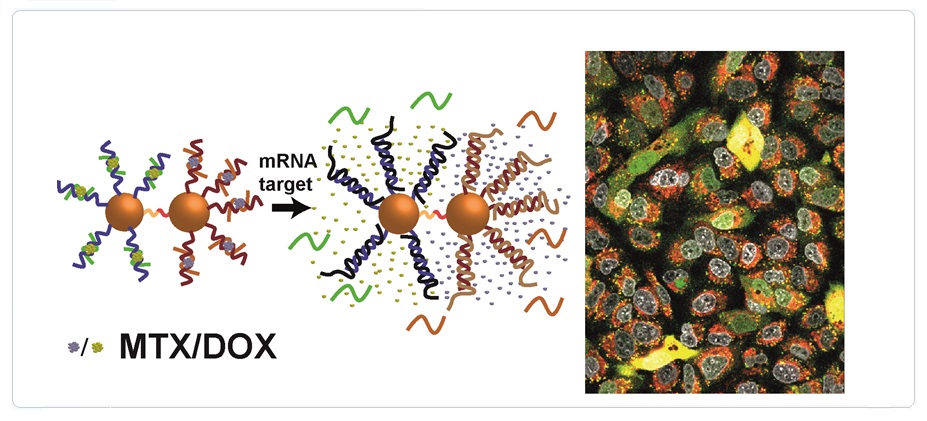
Abstract
The design of nanoparticulate systems which can perform multiple synergistic functions in
cells with high specificity and selectivity is of great importance in applications. Here we
combine recent advances in DNA-gold nanoparticle self-assembly and sensing to develop gold
nanoparticle dimers that are able to perform multiplexed synergistic functions within a
cellular environment. These dimers can sense two mRNA targets and simultaneously or
independently deliver one or two DNA-intercalating anticancer drugs (doxorubicin and mitoxantrone)
in live cells. Our study focuses on the design of sophisticated nanoparticle assemblies
with multiple and synergistic functions that have the potential to advance sensing and
drug delivery in cells
For citations:
Kyriazi, M. E.; Giust, D.; El-Sagheer, A. H.; Lackie, P.M.; Muskens, O.L.; Brown, T.;
Kanaras,* A. G.
"Multiplexed mRNA Sensing and Combinatorial-Targeted Drug Delivery Using DNA-Gold Nanoparticle Dimers"
ACS Nano, 2018, 12 (4), 3333–3340 DOI:10.1021/acsnano.7b08620
Cells on hierarchically-structured platforms hosting functionalized nanoparticles
Biomaterials Science 2018, 6, 1469-1479 DOI:10.1039/C7BM00904F
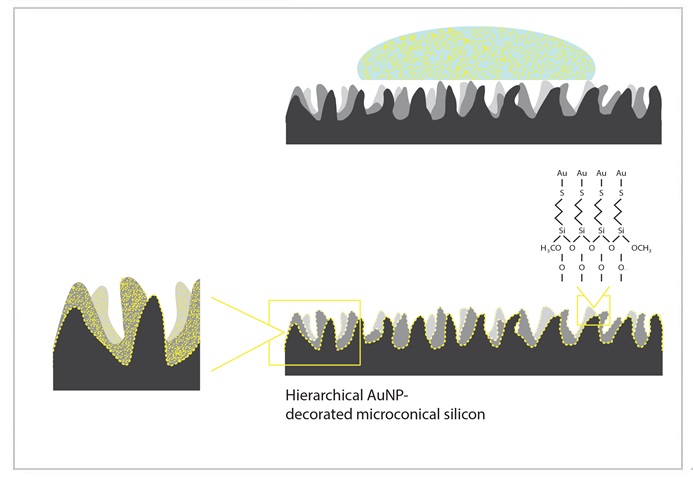
Abstract
In this work, we report on a novel approach to develop hierarchically-structured
cell culture platforms incorporating functionalized gold nanoparticles (AuNPs). In particular,
the hierarchical substrates comprise primary pseudo-periodic arrays of silicon microcones
combined with a secondary nanoscale pattern of homogenously deposited AuNPs terminated with
bio-functional moieties. AuNPs with various functionalities (i.e. oligopeptides, small molecules
and oligomers) were successfully attached onto the microstructures. Experiments with PC12 cells
on the hierarchical substrates incorporating AuNPs carrying the RGD peptide showed an impressive
growth and NGF-induced differentiation of the PC12 cells, compared to that on the NPs-free, bare,
micropatterned substrates. The exploitation of the developed methodology for the binding of AuNPs
as carriers of specific bio-functional moieties onto micropatterned culture substrates for cell
biology studies is envisaged.
For citations:
Simitzi, C.; Harimech, P. K.; Spanou, S.; Lanara, C.; Heuer-Jungemann, A.; Manousaki, A.; Fotakis, C.;
Ranella,A.; Kanaras, A.G.; Stratakis, E.
"Cells on hierarchically-structured platforms hosting functionalized nanoparticles"
Biomater. Sci., 2018, 6, 1469-1479 DOI:10.1039/C7BM00904F
Sensing of Vimentin mRNA in 2D and 3D Models of Wounded Skin Using DNA-Coated Gold Nanoparticles
Small, 2018, 14(12), 1703489
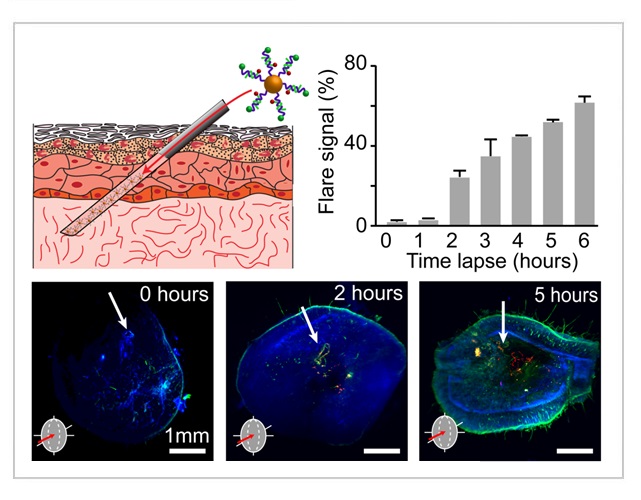
Abstract
Wound healing is a highly complex biological process, which is accompanied
by changes in cell phenotype, variations in protein expression, and the
production of active biomolecules. Currently, the detection of proteins in cells
is done by immunostaining where the proteins in fixed cells are detected by
labeled antibodies. However, immunostaining cannot provide information
about dynamic processes in living cells, within the whole tissue. Here, an easy
method is presented to detect the transition of epithelial to mesenchymal
cells during wound healing. The method employs DNA-coated gold nanoparticle
fluorescent nanoprobes to sense the production of Vimentin mRNA
expressed in mesenchymal cells. Fluorescence microscopy is used to achieve
temporal detection of Vimentin mRNA in wounds. 3D light-sheet microscopy
is utilized to observe the dynamic expression of Vimentin mRNA spatially
around the wounded site in skin tissue. The use of DNA–gold nanoprobes to
detect mRNA expression during wound healing opens up new possibilities for
the study of real-time mechanisms in complex biological processes.
For citations:
Vilela, P.; Heuer-Jungemann, A.; El-Sagheer, H. A.;Brown, T.; Muskens, O. L.; Smyth, N. R.; Kanaras* A. G.
"Sensing of Vimentin mRNA in 2D and 3D Models of Wounded Skin Using DNA-Coated Gold Nanoparticles"
Small, 2018, 14(12), 1703489 DOI: 10.1002/smll.201703489
Spectroscopic and Hydrodynamic Characterisation of DNA-Linked Gold Nanoparticle Dimers in Solution using Two-Photon Photoluminescence.
Chemical Physics Physical Chemistry, 2018, 19(7), 827-836
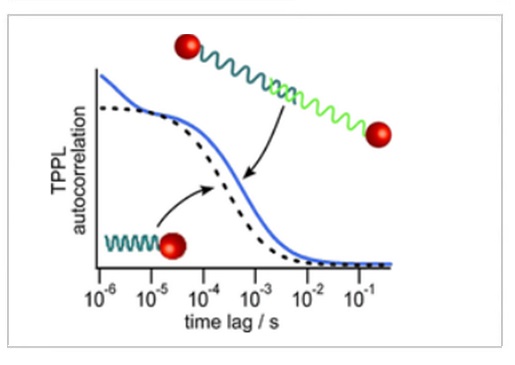
Abstract
Two-photon photoluminescence (TPPL) emission spectra of DNA–gold nanoparticle (AuNP) monoconjugates
and the corresponding DNA-linked AuNP dimers are obtained by photon time-of-flight spectroscopy. This
technique is combined with two-photon photoluminescence fluctuation correlation spectroscopy (TPPL–FCS)
to simultaneously monitor the optical and hydrodynamic behaviour of these nano-assemblies in solution,
with single-particle sensitivity and microsecond temporal resolution. In this study, the AuNPs have an
average core diameter of 12 nm, which renders their dark-field plasmonic light scattering too weak for
single-particle imaging. Moreover, as a result of the lack of plasmonic coupling in the dimers, the optical
extinction, scattering and photoluminescence spectra of the DNA–AuNP complexes are not sufficiently different
to distinguish between monomers and dimers. The use of TPPL–FCS successfully addresses these bottlenecks
and enables the distinction between AuNP monomers and AuNP dimers in solution by measurement of their
hydrodynamic rotational and translational diffusion.
For citations:
Midelet, J.; El-Sagheer, H. A.;Brown, T.; Kanaras* A. G.; Debarre,* A.; Werts,* M. H. V.
"Spectroscopic and Hydrodynamic Characterisation of DNA-Linked Gold Nanoparticle Dimers in Solution using Two-Photon Photoluminescence"
ChemPhysChem 2018, 19(7), 827-836 DOI:10.1002/cphc.201701228
Potentiating angiogenesis arrest in vivo via laser irradiation of peptide functionalised gold nanoparticles
Journal of Nanobiotechnology 2017,15:85, 1-8

Abstract
Anti-angiogenic therapy has great potential for cancer therapy with several FDA approved formulations
but there are considerable side effects upon the normal blood vessels that decrease the potential application of
such therapeutics. Chicken chorioallantoic membrane (CAM) has been used as a model to study angiogenesis in vivo.
Using a CAM model, it had been previously shown that spherical gold nanoparticles functionalised with an anti-angiogenic
peptide can humper neo-angiogenesis.Our results show that gold nanoparticles conjugated with an anti-angiogenic
peptide can be combined with visible laser irradiation to enhance angiogenesis arrest in vivo.
We show that a green laser coupled to gold nanoparticles can achieve high localized temperatures able
to precisely cauterize blood vessels. This combined therapy acts via VEGFR pathway inhibition,
leading to a fourfold reduction in FLT-1 expression.The proposed phototherapy extends the use of
visible lasers in clinics, combining it with chemotherapy to potentiate cancer treatment. This approach
allows the reduction of dose of anti-angiogenic peptide,thus reducing possible side effects, while
destroying blood vessels supply critical for tumour progression.
For citations:
Pedrosa, P.; Heuer-Jungemann, A.; Kanaras A. G.; Fernandes, A. R.; Baptista, P. V.
"Potentiating angiogenesis arrest in vivo via laser irradiation of peptide functionalised gold nanoparticles"
J. Nanobiotechol.2017, 15:85, 1-8 DOI 10.1186/s12951-017-0321-2
The sedimentation of Colloidal Nanoparticles in Solution and Its Study Using Quantitative Digital Photography
Particle & Particle Systems Characterization 2017, 34(10), 1700095
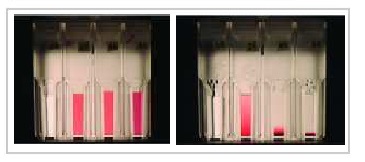
Abstract
Sedimentation and diffusion are important aspects of the behavior of colloidal
nanoparticles in solution, and merit attention during the synthesis, characterization, and
application of nanoparticles. Here, the sedimentation of nanoparticles is studied
quantitatively using digital photography and a simple model based on the
Mason–Weaver equation. Good agreement between experimental time-lapse
photography and numerical solutions of the model is found for a series of gold
nanoparticles. The new method is extended to study for the first time the gravitational
sedimentation of DNA-linked gold nanoparticle dimers as a model system of a higher
complexity structure. Additionally, simple formulas are derived for estimating suitable
parameters for the preparative centrifugation of nanoparticle solutions.
For citations:
Midelet, J.; El-Sagheer, A.H.; Brown, T.; Kanaras, A. G.; Werts, M. H. V.
"The sedimentation of Colloidal Nanoparticles in Solution and Its Study Using Quantitative Digital Photography"
Part. Part. Syst. Charact. 2017, 34(10), 1700095 DOI: 10.1002/ppsc.201700095
Giant Bandgap Renormalization and Exciton-Phonon Scattering in Perovskite Nanocrystals
Advanced Optical Materials, 2017,5 (17), 1700231
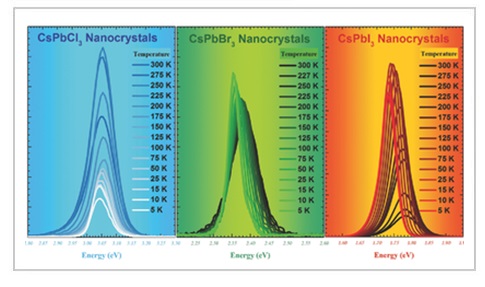
Abstract
Understanding the interactions between photoexcited charge carriers (electrons and holes) with lattice
vibrations (phonons) in quantum confined semiconductor nanocrystals (NCs) is of fundamental interest and
a prerequisite for their use in fabricating high-performance optoelectronic devices. Such interactions
have a significant impact on their optoelectronic properties including their charge carrier mobility
and photoluminescence. Here, we investigate these interactions in cesium lead halide (CsPbX3,
where X is Cl, Br or I) NC perovskites. We show that a wide broadening of the excitonic linewidth
in these NCs arises from strong exciton-phonon coupling, which is substantially dominated by longitudinal
optical phonons via the Fröhlich interaction. Unlike the behavior of conventional semiconductors
these NCs display a general red-shift of their emission energy peak with reducing temperature.
Interestingly, the CsPbCl3 NCs also display an initial blue-shift and undergo at structural phase
transition at ~175 K to 200 K. The anomalous red-shift observed is modeled and analyzed using a
Bose-Einstein two-oscillator model to interpret the interaction of excitons with acoustic and
optical phonons which induce a renormalization of the bandgap. The net renormalization due to
zero point motion (T= 0 K) was found to be ~41.6 meV and ~94.9 meV for CsPbBr3 and CsPbI3 NCs respectively.
For citations:
Saran R.;Heuer-Jungemann, A.; Kanaras, A. G.; Curry, R.
"Giant Bandgap Renormalization and Exciton-Phonon Scattering in Perovskite Nanocrystals"
Adv. Opt. Mater. 2017, 5 (17), 1700231 DOI: 10.1002/adom.201700231
Graphene oxide-upconversion nanoparticle based optical sensors for targeted detection of mRNA biomarkers present in Alzheimer’s disease and prostate cancer
ACS Sensors, 2017,2 (1), 52-56 DOI: 10.1021/acssensors.6b00651

Abstract
The development of new sensors for the accurate detection of biomarkers
in biological fluids is of ultmost importance for the early diagnosis of diseases.
Next to advanced laboratory techniques, there is a need for relatively simple methods
which can significantly broaden the availability of diagnostic capability.
Here, we demonstrate the successful application of a sensor platform based on
graphene oxide and upconversion nanoparticles (NPs) for the specific detection
of mRNA-related oligonucleotide markers in complex biological fluids. The combination
of near-infrared light upconversion with low-background photon counting readout enables
reliable detection of low quantities of small oligonucleotide sequences in the femtomolar
range. We demonstrate the successful de-tection of analytes relevant to mRNAs present in
Alzheimer’s disease as well as prostate cancer in human blood serum. The high performance
and relative simplicity of the upconversion NP-graphene sensor platform enables new
opportunities in early diagnosis based on specific detection of oligonucleotide sequences
in complex environments.
For citations:
Vilela, P.; El-Sagheer, A. H.; Millar T. M.; Brown, T.; Muskens, O. L.; Kanaras,* A. G.
"Graphene oxide-upconversion nanoparticle based optical sensors for targeted detection of mRNA biomarkers present in Alzheimer’s disease and prostate cancer"
ACS Sensors 2017, 2 (1), 52-56 DOI: 10.1021/acssensors.6b00651
Selective killing of cells triggered by their mRNA signature in the presence of smart nanoparticles
Nanoscale, 2016,8 (38), 16857-16861 DOI: 10.1039/c6nr06154k

Abstract
The design of nanoparticles that can selectively perform multiple roles is of
utmost importance for the development of the next generation of nanoparticulate drug
delivery systems. So far most research studies are focused on the customization of
nanoparticulate carriers to maximize their drug loading, enhance their optical signature
for tracking in cells or provide photo-responsive effects for therapeutic purposes.
However, a vital requirement of the new generation of drug carriers must be the
ability to deliver their payload selectively only to cells of interest rather than
the majority of various cells in the vicinity. Here we show for the first time a
new design of nanoparticulate drug carriers that can specifically distinguish
different cell types based on their mRNA signature.These nanoparticles sense and
efficiently kill model tumour cells by the delivery of an anti-cancer drug but retain
their payload in cells lacking the specific mRNA target.
For citations:
Heuer-Jungemman, A.; El-Sagheer, A.H.; Lackie, P. M.; Brown, T.; Kanaras,* A. G.
"Selective killing of cells triggered by their mRNA signature in the presence of smart nanoparticles"
Nanoscale 2016,8 (38), 16857-16861 DOI: 10.1039/c6nr06154k
Polymer-Enhanced Stability of Inorganic Perovskite Nanocrystals and their Application in Color Conversion LEDs
ACS Applied Materials and Interfaces, 2016, 8 (30), 19579–19586 DOI: 10.1021/acsami.6b02529
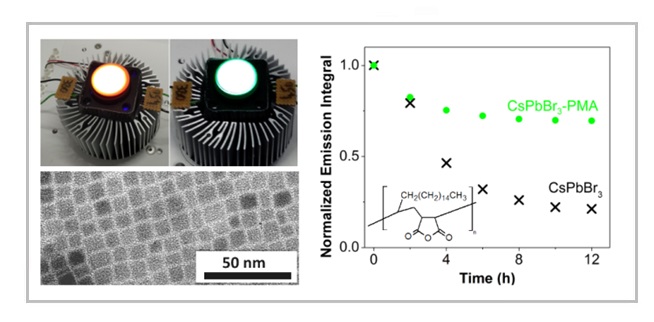
Abstract
Cesium lead halide (CsPbX3, X = Cl, Br, I) nanocrystals (NCs) offer exceptional optical properties for several
potential applications but their implementation is hindered by a low chemical and structural stability and
limited processability. In the present work, we developed a new method to efficiently coat CsPbX3 NCs,
which resulted in their increased chemical and optical stability as well as processability. The method is
based on the incorporation of poly(maleic anhydride-alt-1-octadecene) (PMA) into the synthesis of the
perovskite NCs. The presence of PMA in the ligand shell stabilizes the NCs by tightening the ligand binding,
limiting in this way the NC surface interaction with the surrounding media. We further show that these NCs
can be embedded in self-standing silicone/glass plates as down-conversion filters for the fabrication of
monochromatic green and white light emitting diodes (LEDs) with narrow bandwidths and appealing color
characteristics.
For citations:
Meyns, M.;Perálvarez, M.; Heuer-Jungemann, A.; Hertog,W.; Ibáñez,M.;Nafria,R.;Genç,A.;Arbiol,J.; Kovalenko, M. V.; Carreras,*J.;
Cabot,* A.;Kanaras,* A. G.
ACS Appl.Mater.Interfaces 2016, 2016, 8 (30), 19579–19586 DOI: 10.1021/acsami.6b02529
Manganese doped-iron oxide nanoparticle clusters and their potential as agents for magnetic resonance imaging and hyperthermia
Physical Chemistry Chemical Physics, 2016, 18 (25), 16848-16855, DOI: 10.1039/c6cp02094a
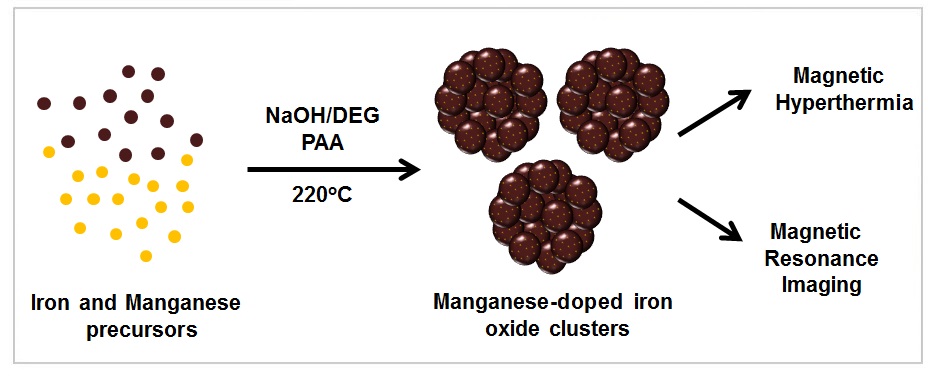
Abstract
A simple, one pot method to synthesize water-dispersible Mn doped iron oxide colloidal
clusters constructed of nanoparticles arranged into secondary flower-like structures was developed.
This method allows the successful incorporation and homogeneous distribution of Mn within
the nanoparticle iron oxide clusters. The formed clusters retain the desired morphological
and structural features observed for pure iron oxide clusters,but possess intrinsic magnetic
properties that arise from Mn doping. They show distinct performance as imaging contrast agents
and excellent characteristics as heating mediators in magnetic fluid hyperthermia. It is
expected that the outcomes of this study will open up new avenues for the exploitation of
doped magnetic nanoparticle assemblies in biomedicine.
For citations:
Casula, M. F.; Conca, E.;Bakaimi, I.; Sathya, A.; Materia M. E.;Casu, A.; Falqui, A.; Sogne, E.; Pellegrino, T.; Kanaras,* A. G.
"Manganese doped-iron oxide nanoparticle clusters and their potential as agents for magnetic resonance imaging and hyperthermia"
Phys. Chem. Chem. Phys. 2016 18 (25), 16848-16855, DOI: 10.1039/c6cp02094a
Peptide-coated gold nanoparticles for modulation of angiogenesis in vivo
International Journal of Nanomedicine 2016,11,2633-2639 DOI:10.2147/IJN.S108661
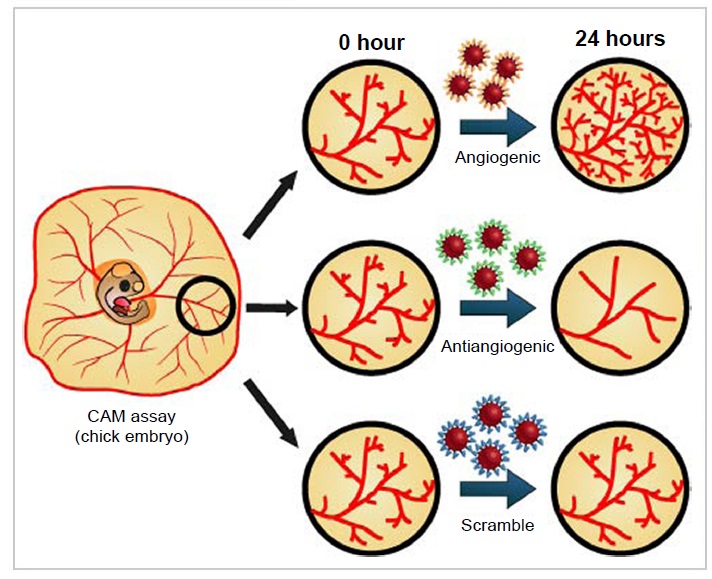
Abstract
In this work, peptides designed to selectively interact with cellular receptors
involved in the regulation of angiogenesis were anchored to oligo-ethylene glycol-capped
gold nanoparticles (AuNPs) and used to evaluate the modulation of vascular development
using an ex ovo chick chorioallantoic membrane assay. These nanoparticles alter the balance
between naturally secreted pro- and antiangiogenic factors, under various biological conditions,
without causing toxicity. Exposure of chorioallantoic membranes to AuNP–peptide activators of
angiogenesis accelerated the formation of new arterioles when compared to scrambled peptide-coated
nanoparticles. On the other hand, antiangiogenic AuNP–peptide conjugates were able to
selectively inhibit angiogenesis in vivo. We demonstrated that AuNP vectorization is crucial
for enhancing the effect of active peptides. Our data showed for the first time the effective
control of activation or inhibition of blood vessel formation in chick embryo via AuNP-based
formulations suitable for the selective modulation of angiogenesis, which is of paramount
importance in applications where promotion of vascular growth is desirable (eg, wound healing)
or ought to be contravened, as in cancer development.
For citations:
Roma-Rodrigues, C.; Heuer-Jungemann, A.; Fernandes, A. R.; Kanaras, A. G.; Baptista, P. V.
"Peptide-coated gold nanoparticles for modulation of angiogenesis in vivo"
Int. J. Nanomedicine 2016,11,2633-2639 DOI:10.2147/IJN.S108661
The adsorbed state of a thiol on palladium nanoparticles
Physical Chemistry Chemical Physics 2016, 18 (26), 17265-17271, DOI: 10.1039/C6CP00957C
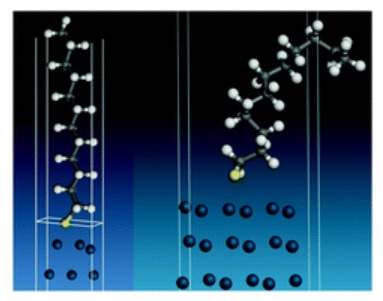
Abstract
In the present work, a combination of imaging, spectroscopic and computational methods
shows that 1-dodecanethiol undergoes S-deprotonation to form 1-dodecanethiolate on the
surface of palladium nanoparticles, which then self-assembles into a structure that shows a
high degree of order. The alkyl chain is largely in the all-trans conformation, which occurs
despite the small size of the nanoparticle, (mean diameter = 3.9 nm). Inelastic neutron
scattering spectroscopy is readily able to characterise organic surface layers on nanoparticles;
the nature of the material is irrelevant: whether the nanoparticle core is an oxide, a metal or a
semiconductor makes no difference. Comparison to DFT calculations allows insights into the
nature and conformation of the adsorbed layer.
For citations:
Rogers, M. S.; Dimitratos, N.; Jones, W.; Bowker, M.; Kanaras, A. G.; Wells, P. P.; Catlow, R. A.; Parker, S. F.
"The adsorbed state of a thiol on palladium nanoparticles"
Phys. Chem. Chem. Phys. 2016, 18 (26), 17265-17271, DOI: 10.1039/C6CP00957C
Fast Assembly of gold nanoparticles in large-area 2d nanogrids using a one step, near infrared radiation assisted evaporation process
ACS Nano. 2016,10 (2), 2232-2242 DOI:10.1021/acsnano.5b06886
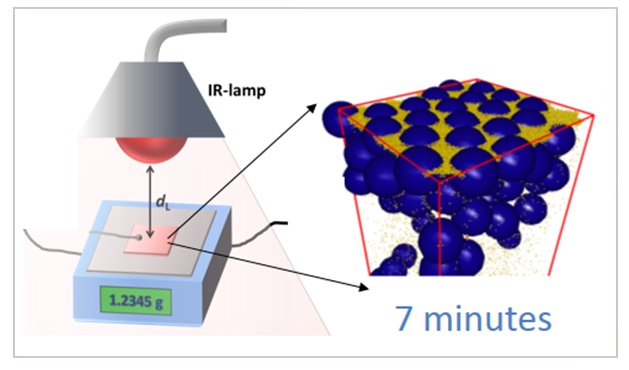
Abstract
When fabricating photonic crystals from suspensions in volatile liquids using the horizontal
deposition method, the conventional approach is to evaporate slowly to increase the time for
particles to settle in an ordered, periodic close-packed structure. Here, we show that the greatest
ordering of 10 nm aqueous gold nanoparticles (AuNPs) in a template of larger spherical polymer particles
(mean diameter of 338 nm) is achieved with very fast water evaporation rates obtained with near-infrared
radiative heating. Fabrication of arrays over areas of a few cm2 takes only 7 min. The assembly process
requires that the evaporation rate is fast relative to the particles’ Brownian diffusion.
Then a two-dimensional colloidal crystal forms at the falling surface, which acts as a sieve through
which the AuNPs pass, according to our Langevin dynamics computer simulations. With sufficiently
fast evaporation rates, we create a hybrid structure consisting of a two-dimensional AuNP nanoarray
(or “nanogrid”) on top of a three-dimensional polymer opal. The process is simple, fast, and one-step.
The interplay between the optical response of the plasmonic Au nanoarray and the microstructuring of the
photonic opal results in unusual optical spectra with two extinction peaks, which are analyzed via
finite-difference time-domain method simulations. Comparison between experimental and modeling results
reveals a strong interplay of plasmonic modes and collective photonic effects, including the formation
of a high-order stopband and slow-light-enhanced plasmonic absorption. The structures, and hence their optical
signatures, are tuned by adjusting the evaporation rate via the infrared power density.
For citations:
Utgenannt, A.;Maspero, R.; Fortini, A.; Turner, R.; Florescu, M.; Jeynes, C.; Kanaras, A. G.; Muskens, O. L.; Sear, R. P.; Keddie, J. L.
"Fast Assembly of gold nanoparticles in large-area 2d nanogrids using a one step, near infrared radiation assisted evaporation process "
ACS Nano 2016,10 (2), 2232-2242 DOI:10.1021/acsnano.5b06886
Plasmonic Backscattering Effect in High-Efficient Organic Photovoltaic Devices
Adv. Energ. Mater. 2016, 6 (2), 1501640 DOI:10.1002/aenm.201501640
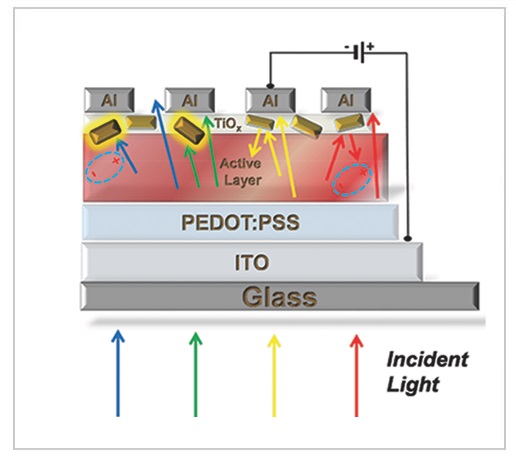
Abstract
A universal strategy for efficient light trapping through the incorporation of gold nanorods on the
electron transport layer (rear) of organic photovoltaic devices is demonstrated. Utilizing the photons
that are transmitted through the active layer of a bulk heterojunction photovoltaic device and would
otherwise be lost, a significant enhancement in power conversion efficiency (PCE) of (PCDTBT:PC71BM) and
(PTB7):PC71BM by 13% and 8%, respectively.PCEs over 8% are reported for devices based on the PTB7:PC71BM blend.
A comprehensive optical and electrical characterization of our devices to clarify the influence of gold nanorods
on exciton generation, dissociation,charge recombination, and transport inside the thin film devices is performed.
By correlating the experimental data with detailed numerical simulations,the near-field and far-field scattering
effects are separated of gold nanorods (Au NRs), and confidently attribute part of the performance enhancement
to the enhanced absorption caused by backscattering. While, a secondary contribution from the Au NRs that
partially protrude inside the active layer and exhibit strong near-fields due to localized surface
plasmon resonance effects is also observed but is minor in magnitude.Furthermore, another important
contribution to the enhanced performance is electrical in nature and comes from the increased charge
collection probability.
For citations:
Kakavelakis, G.; Vangelidis, I.; Heuer-Jungemann, A.; Kanaras, A. G.; Lidorikis, E.; Stratakis, E.; Kymakis, E.
"Plasmonic Backscattering Effect in High-Efficient Organic Photovoltaic Devices "
Adv. Energ. Mater. 2016, 6 (2), 1501640 DOI:10.1002/aenm.201501640
Programming the assembly of gold nanoparticles on graphene oxide sheets using DNA
J. Mater. Chem. C. 2015, 3, 9379 - 9384 DOI: 10.1039/C5TC01999K
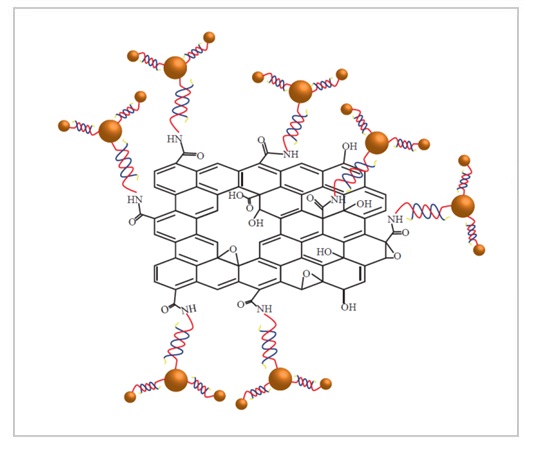
Abstract
We present a new method to program the covalent binding of gold nanoparticles onto graphene oxide
sheets. The binding selectivity is driven by the synergy of chemically modified oligonucleotides, grafted
onto the surfaces of nanoparticles and graphene oxide. In the presence of a templating complementary
DNA strand, nanoparticles are brought near the surface of the graphene oxide. Once in close proximity,
the DNA strands are ligated to create a permanent link between the nanoparticles and graphene oxide,
ensuring stability of the system even during DNA melting conditions. Due to the selectivity and
specificity of DNA, a second layer of gold nanoparticles of different size can be grafted on the top of the
first layer of particles. The simplicity of this new method allows for its universal applicability when the
formation of highly programmable, covalently linked hybrid nanoparticle–graphene oxide structures is a
necessity.
For citations:
Heuer-Jungemann, A.;Kiessling, L.; Stratakis, E.; Kymakis, E.; El-Sagheer, A. H.; Brown, T.; Kanaras, A. G.*
"Programming the assembly of gold nanoparticles on graphene oxide sheets using DNA "
J. Mater. Chem. C, 2015, 3, 9379 - 9384 DOI: 10.1039/C5TC01999K
Reversible Ligation of Programmed DNA-Gold Nanoparticle Assemblies
J. Am. Chem. Soc., 2015, 137 (29), 9242–9245 DOI: 10.1021/jacs.5b05683
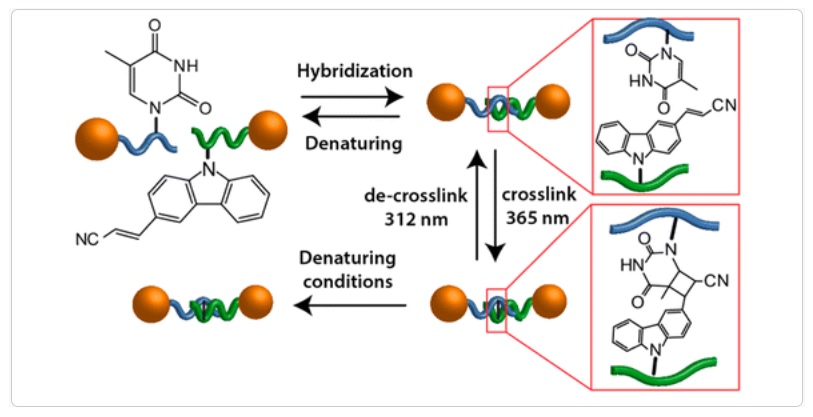
Abstract
We demonstrate a new method to reversibly cross-link DNA-nanoparticle dimers,
trimers, and tetramers using light as an external stimulus. A DNA interstrand
photo-cross-linking reaction is possible via ligation of a cyano-vinyl carbazole
nucleoside with an opposite thymine when irradiated at 365 nm. This reaction results
in nanoparticle assemblies that are not susceptible to DNA dehybridization conditions.
The chemical bond between the two complementary DNA strands can be reversibly broken
upon light irradiation at 312 nm. This is the first example of reversible ligation in
DNA-nanoparticle assemblies using light and enables new developments in the field of
programmed nanoparticle organization.
For citations:
Harimech, P.K.;Gerrard, S. R.; El-Sagheer, A. H.; Brown, T.; Kanaras, A. G.
"Reversible Ligation of Programmed DNA-Gold Nanoparticle Assemblies"
J. Am. Chem. Soc. 2015, 137 (29), 9242-9245 DOI: DOI: 10.1021/jacs.5b05683
Plasmonic Bulk Heterojunction Solar Cells: The Role of Nanoparticle Ligand Coating
ACS Photonics, 2015, 2 (6), 714–723 DOI:10.1021/acsphotonics.5b00202
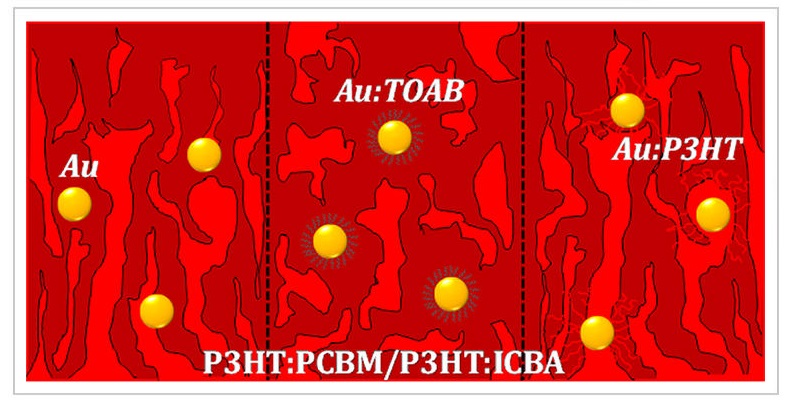
Abstract
There has been a lot of interest regarding the influence of active layer
incorporated plasmonic nanoparticles (NPs) in the performance of bulk
heterojunction organic photovoltaic (OPV) devices, while both an increase and
decrease in performance have been reported. In this paper, following a systematic
approach, we demonstrate strong evidence of the critical importance of the NPs’ ligand
shell on the device performance. In particular, it is argued that the plasmonic
effect accountable for the performance enhancement takes place only in the case in
which the NP’s core is in direct contact with the active layer polymer donor.
This can be achieved with the utilization of either ligand free NPs or NPs terminated
with the same polymer donor as the active layer. Using this concept we achieved an enhanced
efficiency of 7.16% in OPV devices incorporating the poly(3-hexylthiophene-2,5-diyl)
(P3HT):indene-C60 bisadduct (ICBA) active layer. On the contrary, devices with ligand-terminated
Au NPs show lower performance, even compared with the reference, NP-free, device due to the
deteriorated active layer morphology attained, which leads to exciton quenching. These new
insights into the plasmonic light-harvesting technology could shed light on the existing
controversy and provide guidelines for device design and fabrication.
For citations:
Kymakis, E.; Spyropoulos, G. D.; Fernandes, R.; Kakavelakis, G.; Kanaras, A. G.; Stratakis, E.
“Plasmonic Bulk Heterojunction Solar Cells: The Role of Nanoparticle Ligand Coating”
ACS Photonics 2015, 2 (6), 714-723 DOI: 10.1021/acsphotonics.5b00202
Nanoparticles for inhibition of in vitro tumour angiogenesis: Synergistic actions of ligand function and laser irradiation
Biomaterials Science 2015, 3, 733-741 DOI: 10.1039/c5m00053j
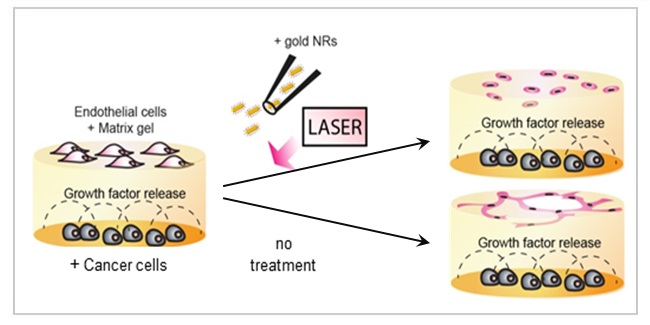
Abstract
Careful design of nanoparticles plays a crucial role in their biomedical applications.
It not only defines the stability of nanoparticles in a biological medium but also programs
their biological functionality and specific interactions with cells. Here, an inorganic
nanoparticulate system engineered to have a dual role as anti-angiogenic and hyperthermic
agent is presented. The inorganic rod-shaped core is designed to strongly absorb
near-infrared laser irradiation through the surface plasmon resonance and convert
it into localized heat, while a peptide coating acts as an anti-angiogenic drug, altogether
inhibiting vascular growth. The synergistic dual action provides an improved inhibition
of the in vitro tumour angiogenesis, offering new possibilities for the development of
nano-engineered anti-angiogenic drugs for therapies.
For citations:
Bartczak, D.; Muskens, O. L.; Nitti, S.; Millar, T. M.; Kanaras,* A. G
“Nanoparticles for inhibition of in vitro tumour angiogenesis: Synergistic actions of ligand function and laser irradiation.”
Biomater. Sci. 2015, 3, 733-741 DOI: 10.1039/c5m00053j
Highly sensitive DNA sensor based on upconversion nanoparticles and graphene oxide.
ACS Appl. Mater. Interfaces, 2015, 7 (23), 12422–12429 DOI: 10.1021/am507591u
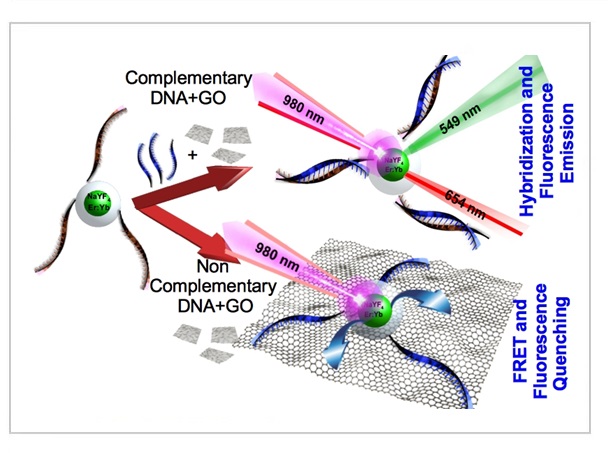
Abstract
In this work we demonstrate a DNA biosensor based on fluorescence resonance
energy transfer (FRET) between NaYF4:Yb,Er nanoparticles and graphene oxide (GO).
Monodisperse NaYF4:Yb,Er nanoparticles with a mean diameter of 29.1 ± 2.2 nm were synthesized
and coated with a SiO2 shell of 11 nm, which allowed the attachmentof single strands
of DNA. When these DNA-functionalized NaYF4:Yb,Er@SiO2 nanoparticles were in the
proximity of the GO surface, the p-p stacking interaction between the nucleobases of the
DNA and the sp2 carbons of the GO induced a FRET fluorescence quenching due to the
overlap of the fluorescence emission of the NaYF4:Yb,Er@SiO2 and the absorption spectrum
of GO. By contrast, in the presence of the complementary DNA strands, the hybridization
leads to double-stranded DNA that does not interact with the GO surface, and thus
the NaYF4:Yb,Er@SiO2 nanoparticles remain unquenched and fluorescent. The high sensitivity
and specificity of this sensor introduces a new method for the detection of DNA with a
detection limit of 5 pM.
For citations:
Alonso-Cristobal,P.; Vilela, P.; El- Sagheer, A. H.;Lopez-Cabarcos, E.; Brown, T.; Muskens, O. L.;
Rubio-Retama,* J.; Kanaras,* A. G
“Highly Sensitive DNA Sensor based on upconversion nanoparticles and graphene oxide.”
ACS Appl. Mater. Interfaces 2015, 7 (23), 12422-12429, DOI: 10.1021/am507591u
Interactions of Skin with Gold Nanoparticles of Different Surface Charge, Shape and Functionality.
Small 2015, 11 (6), 713-721. DOI: 10.1002/smll.201401913
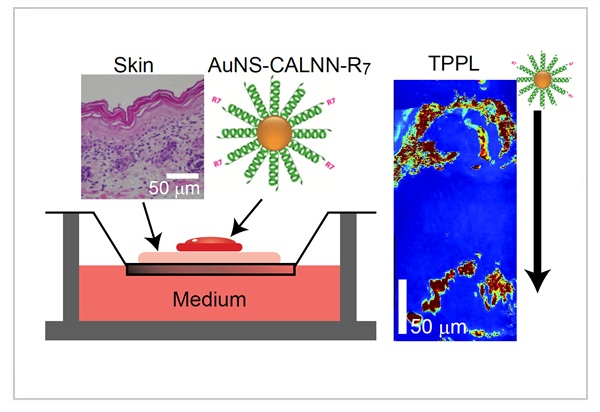
Abstract
We investigate the interactions between skin and colloidal gold nanoparticles
of different physicochemical characteristics. By systematically varying the charge,
shape and functionality of gold nanoparticles, we assess the nanoparticle penetration
through the different skin layers. The penetration is evaluated both qualitatively
and quantitatively using a variety of complementary techniques. Inductively coupled
plasma optical emission spectrometry (ICP-OES) is used to quantify the total number
of particles penetrated into the skin structure. Transmission electron microscopy (TEM)
and two photon photoluminescence microscopy (TPPL) on skin cross sections provide
a direct visualization of nanoparticle migration within the different skin substructures.
Our studies reveal that gold nanoparticles functionalized with cell penetrating peptides
(CPPs) TAT and R7 are found in the skin in larger quantities than polyethylene glycol
functionalized nanoparticles and are able to enter deep into the skin structure.
The systematic studies presented in this work can be of strong interest for new developments
in transdermal administration of drugs and therapy.
For citations:
Fernandes,R.; Smyth,N. R.; Muskens, O.L.;Nitti, S.; Heuer-Jungemann, A.; Ardern-Jones, M. R.; Kanaras,* A. G.
“Interactions of Skin with Gold Nanoparticles of Different Surface Charge, Shape and Functionality.”
Small 2015, 11 (6), 713-721. DOI: 10.1002/smll.201401913
Elastic constants, Viscocity and Response Time in Nematic Liquid Crystals Doped with Ferroelectric Nanoparticles
RSC Advances 2014, 4, 46068-46074 DOI: 10.1039/C4RA06248E
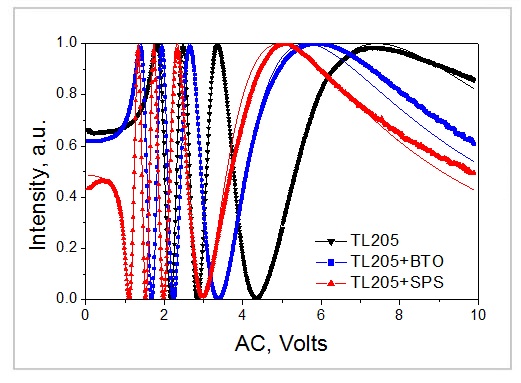
Abstract
We report on the role of ferroelectricity on the physical and electro-optic parameters
in suspensions of nanoparticles in cyclohexane based, fluorinated nematic liquid crystals.
The dielectric and elastic constants, response time, and viscosity of the suspensions were
analyzed experimentally and compared with the undoped samples. Our study shows a decrease
in the splay elastic constant and an increase in the dielectric constants, together with
an increase in the average rotational viscosity.
For citations:
Podoliak, N.;Buchnev, O.; Herrington,M.; Mavrona, E.; Kaczmarek, M.; Kanaras,A. G.; Stratakis, E.; Blach,J. F.; Henninot, J. F.; Warenghem, M.
“Elastic constants, Viscocity and Response Time in Nematic Liquid Crystals Doped with Ferroelectric Nanoparticles”
RSC Advances 2014, 4, 46068-46074 DOI: 10.1039/C4RA06248E
Assembly of quantum dots on peptide nanostructures and their spectroscopic properties
Applied Physics A, 2014, 116 (3), 977-985 DOI 10.1007/s00339-014-8538-5

Abstract
We present a chemical process for the decoration of self-assembled two-dimensional
peptide fibrils with two different sizes of CdSe@ZnS core–shell quantum dots
(Qdots) capped with trioctylphosphine oxide molecules.The attachment of the
semiconducting nanoparticles to the fibrils is directed via covalent bond between
the quantum dot and cysteine aminoacids that are deliberately impeded in the peptide
structures. A significant red shift in the emission spectra of the quantum dots
is observed and attributed to the synergistic interaction between adjacent
nanoparticles arranged on peptide film templates extending over hundreds of nanometers.
For citations:
Kasotakis, E.; Kostopoulou, A.; Spuch-Calvar, M.; Androulidaki, M.; Pelekanos, N.; Kanaras, A. G.;
Lappas, A.; Mitraki, A.
“Assembly of quantum dots on peptide nanostructures and their spectroscopic properties”
Applied Physics A, 2014, 116 (3), 977-985 DOI 10.1007/s00339-014-8538-5
Interaction of stable colloidal nanoparticles and cellular membranes
Biotechnology Advances, 2014, 32, 679-692.
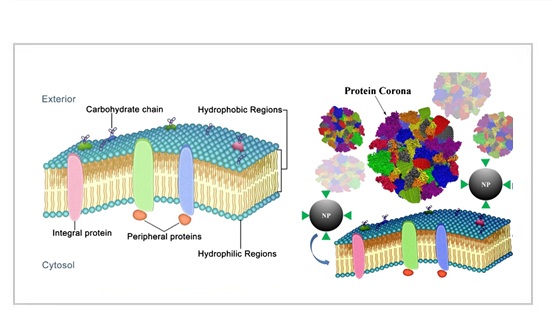
Abstract
Due to their ultra-small size, inorganic nanoparticles (NPs) have distinct properties
compared to the bulk form.The unique characteristics of NPs are broadly exploited in biomedical
sciences in order to develop various methods of targeted drug delivery, novel biosensors
and new therapeutic pathways. However, relatively little is known in the negotiation of NPs
with complex biological environments. Cell membranes (CMs) in eukaryoteshave dynamic structures,
which is a key property for cellular responses to NPs. In this review, we discuss the current
knowledge of various interactions between advanced types of NPs and CMs.
For citations:
Mahmoudi, M.; Meng, J.; Xue, X.; Liang, X. J.; Rahman, M.; Pfeiffer, C.; Hartmann, R.; Gil, P. R.;
Pelaz, B.; Parak, W. J.;del Pino, P.; Carregal-Romero, S.; Kanaras, A. G.; Selvan, S. T.
“Interaction of stable colloidal nanoparticles and cellular membranes”
Biotechnology Advances, 2014, 32, 679-692. DOI:10.1016/j.biotechadv.2013.11.012
Gold Nanoparticles and Fluorescently-Labelled DNA as a Platform for Biological Sensing
Nanoscale, 2013, 5 (20), 9503–9510
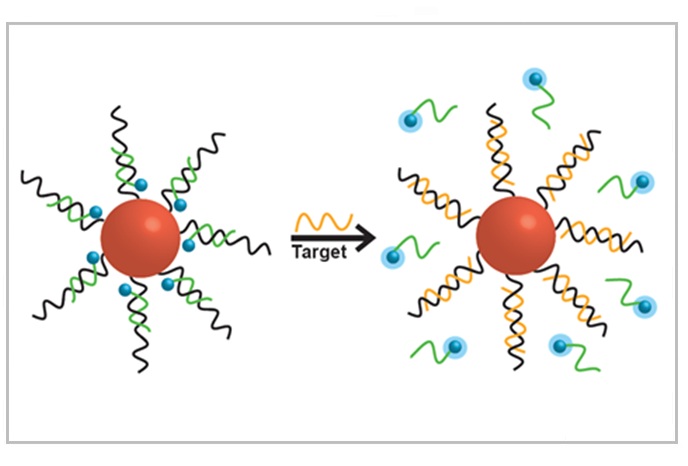
Abstract
In the past decade gold nanoparticle-nucleic acid conjugates became progressively
important for biomedical applications. Fluorophores attached to nucleic acid-gold nanoparticle
conjugates have opened up a new era of biological sensing. The most promising advancement
in this field was the invention of the so-called ‘nano-flare’ systems. These systems are
capable of detecting specific endocellular targets such as mRNAs, microRNAs or small
molecules in real time. In this minireview, we discuss the current progress in the field
of DNA-nanoparticles as sensors, their properties, stability, cellular uptake and cytotoxicity.
For citations:
Heuer-Jungemann, A.; Harimech, P.; Brown, T.; Kanaras* A. G.
“Gold Nanoparticles and Fluorescently-Labelled DNA as a Platform for Biological Sensing”
Nanoscale, 2013,5 (20), 9503–9510 DOI:10.1039/c3nr03707j
Copper-free Click Chemistry as an Emerging Tool for the Programmed Ligation of DNA-functionalised Gold Nanoparticles
Nanoscale, 2013, 5 (16), 7209 - 7212
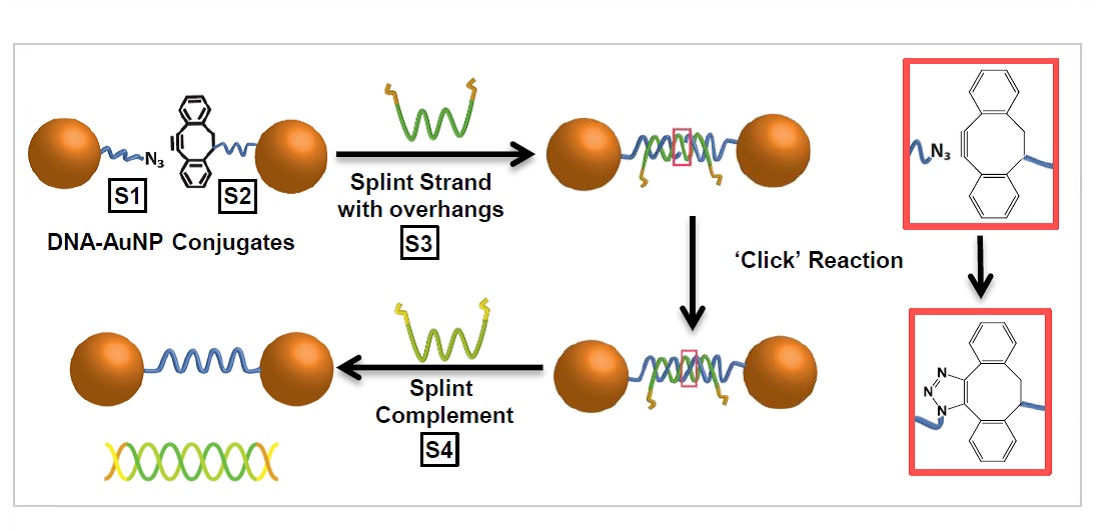
Abstract
We demonstrate a new method to program the ligation of single stranded DNA-modified gold nanoparticles
using copper–free click chemistry. Gold nanoparticles functionalized with a discrete number of 3’-azide or
5’-alkyne modified oligonucleotides, can be brought together via a splint strand and covalently ‘clicked’,
in a simple one-pot reaction. This new approach to the assembly of gold nanoparticles is inherently advantageous
in comparison to the traditional enzymatic ligation. The chemical ligation is specific and takes place at room
temperature by simply mixing the particles without the need for special enzymatic conditions. The yield of
‘clicked’ nanoparticles can be as high as 92%. The ease of the copper-free, ‘click-ligation’ method allows
for its universal applicability and opens up new avenues in programmed nanoparticle organization.
For citations:
Heuer-Jungemann, A.; Kirkwood, R.;El-Sagheer, A.; Brown, T.; Kanaras* A. G.
“Copper-free Click Chemistry as an Emerging Tool for the Programmed Ligation of DNA-functionalised Gold Nanoparticles”
Nanoscale 2013, 5 (16), 7209-7212 DOI:10.1039/C3NR02362A
Manipulation of In Vitro Angiogenesis Using Peptide-Coated Gold Nanoparticles
ACS Nano, 2013, 7 (6), pp 5628–5636
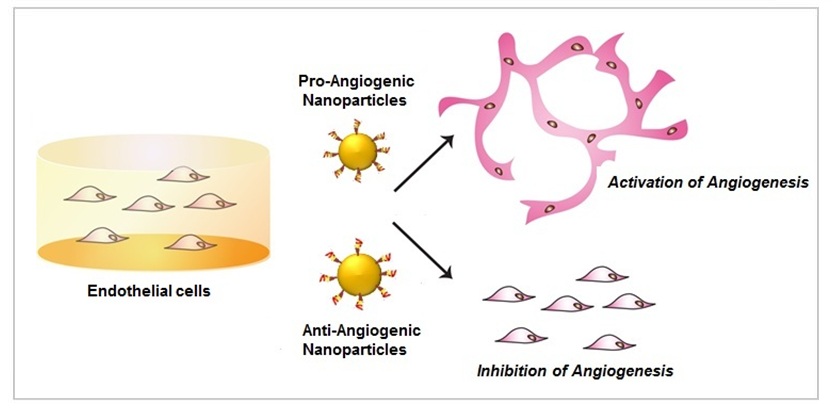
Abstract
We demonstrate the deliberate activation or inhibition of in vitro angiogenesis using functional
peptide coated gold nanoparticles. The peptides, anchored to oligo-ethylene glycol capped gold
nanospheres, were designed to selectively interact with cell receptors responsible for activation
or inhibition of angiogenesis. The functional particles are shown to influence significantly the
extent and morphology of vascular structures, without causing toxicity. Mechanistic studies show
that the nanoparticles have the ability to alter the balance between naturally secreted pro- and
anti- angiogenic factors, under various biological conditions. Nanoparticle-induced control over
angiogenesis opens up new directions in targeted drug delivery and therapy.
For citations:
Bartczak, D.; Muskens, O. L.;Sanchez-Elsner T.;Kanaras* A. G.; Millar T. M.*
“Manipulation of In Vitro Angiogenesis Using Peptide-Coated Gold Nanoparticles”
ACS Nano, 2013, 7 (6), pp 5628–5636 DOI: 10.1021/nn402111z
Porosity-moderated ultrafast electron transport in Au nanowire networks
Applied Physics A, 2013, 111, 711-717
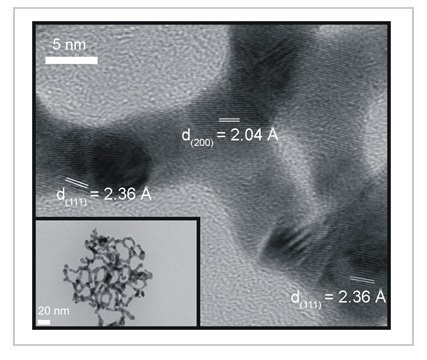
Abstract
We demonstrate for first time the ultrafast properties of a newly formed porous Au nanostructure. The properties
of the porous nanostructure are compared with those of a solid gold film using time-resolved optical spectroscopy.
The experiments suggest that under the same excitation conditions the relaxation dynamics are slower in the former.
Our observations are evaluated by simulations based on a phenomenological rate equation model. The impeded dynamics
has been attributed to the porous nature of the structure in the networks, which results in reduced efficiency during
the dissipation of the laser-deposited energy. Importantly,the porosity of the complex three-dimensional nanostructure
is introduced as a geometrical control parameter of its ultrafast electron transport.
For citations:
Magoulakis, E.; Kostopoulou, A.; Arvanitakis, G. N.; and Kanaras, A G.; Andriotis, A. N.; Lappas, A.; Loukakos, P.A.
“Porosity-moderated ultrafast electron transport in Au nanowire networks”
Applied Physics A, 2013, 111 (3), 711-717 DOI 10.1007/s00339-013-7647-x
Colloidal Branched Semiconductor Nanocrystals: State of the Art and Perspectives
Accounts of Chemical Research, 2013, 46 (7), 1387–1396
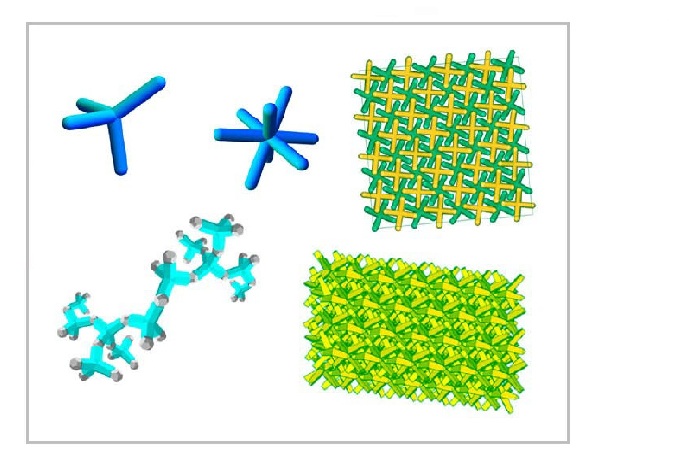
Abstract
Colloidal inorganic nanocrystals are versatile nanoscale building blocks.Advances in their synthesis have yielded
nanocrystals with various morphologies including spheres, polyhedra, rods, disks, sheets, wires, and a wide range of
branched shapes. Recent developments in chemical methods have allowed the synthesis of colloidal nanocrystals made of
sections of different inorganic materials connected together. Many research groups are investigating these nanocrystals’
structural and photophysical properties experimentally and theoretically, and many have examined their prospects for
commercial applications. Branched nanocrystals, in particular, are gaining attention, in part for their potential applications
in solar cells or electronic devices. In this Account, we review recent developments in synthesis and controlled assembly
of colloidal branched nanocrystals.Synthesis of branched nanocrystals builds on previous work with spherical nanocrystals and
nanorods, but a unique factor is the need to control the branching event. Multiple arms can branch from a nucleus, or secondary
branches can form from a growing arm. Branching can be governed by mechanisms including twinning, crystal splitting, polymorphism,
oriented attachment, and others. One of the most relevant parameters is the choice of appropriate surfactant molecules, which can
bind selectively to certain crystal facets or can even promote specific crystallographic phases during nucleation and growth. Also,
seeded growth approaches recently have allowed great progress in the synthesis of nanocrystals with elaborate shapes. In this approach,
nanocrystals with a specified chemical composition, size, shape, crystalline habit, and phase act as seeds on which multiple branches
of a second material nucleate and grow. These approaches yield nanostructures with improved homogeneity in distribution of branch
length and cross section. Ion exchange reactions allow further manipulation of branched nanocrystals by transforming crystals of
one material into crystals with the same size, shape, and anion sublattice but with a new cation. Combining seeded growth with ion
exchange provides a method for greatly expanding the library of branched nanocrystals.Assembly of morphologically complex
nanocrystals is evolving in parallel to developments in chemical synthesis. While researchers have made many advances in the past
decade in controlled assembly of nanocrystals with simple polyhedral shapes, modeling and experimental realization of ordered
superstructures of branched nanocrystals are still in their infancy. In the only case of ordered superstructure reported so far,
the assembly proceeds by steps in a hierarchical fashion, in analogy to several examples of assembly found in nature. Meanwhile,
disordered assemblies of branched nanocrystals are also interesting and may find applications in various fields.
For citations:
Li, H.; Kanaras, A. G.; Manna, L.
“Colloidal Branched Semiconductor Nanocrystals: State of the Art and Perspectives”
Acc. Chem. Res., 2013, 46 (7), 1387–1396 DOI: 10.1021/ar3002409
Directed organization of gold nanoparticles in polymer coatings through infrared-assisted evaporative lithography
Chemical Communications, 2013, 49, 4253-4255
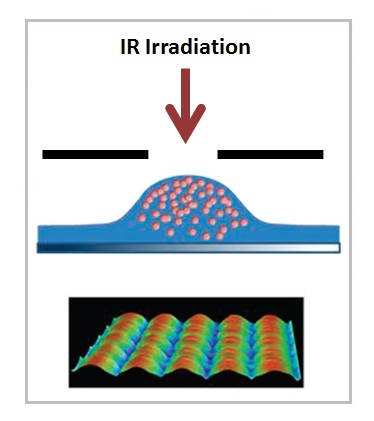
Abstract
Infrared-assisted evaporative lithography (IRAEL) is presented as an emerging technology to
direct the assembly of gold nanospheres (AuNSs) into large-scale superstructures within
colloidal polymeric coatings. The organization of gold nanoparticle arrays within the
superstructures can be tuned over length scales, ranging from micrometers up to several
millimetres, giving rise to intrinsic plasmonic properties.
For citations:
Utgenannt, A.; Keddie, J. L.; Muskens, O.L; and Kanaras, A G.*
“Directed organization of gold nanoparticles in polymer coatings through infrared-assisted evaporative lithography”
Chem. Commun., 2013, 49, 4253-4255 DOI: 10.1039/C2CC37844B (Emerging Investigators 2013)
Hyperspectral darkfield microscopy of single holow gold nanoparticles for biomedical applications
Physical Chemistry Chemical Physics, 2013, 15, 4163-4168
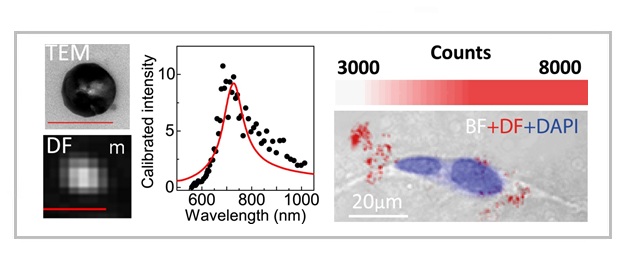
Abstract
Hyperspectral microscopy is a versatile method for simultaneous spatial and spectroscopic
characterization of nonfluorescent samples. Here we present a hyperspectral darkfield imaging
system for spectral imaging of single nanoparticles over an area of 150 x 150 µm2 and at
illumination intensities compatible with live cell imaging. The capabilities of the system
are demonstrated using correlated transmission electron microscopy and single-particle
optical studies of colloidal hollow gold nanoparticles. The potential of the system for
characterizing the interactions between nanoparticles and cells has also been demonstrated.
In this case, the spectral information proves a useful improvement to standard darkfield
imaging as it enables differentiation between light scattered from nanoparticles and light
scattered from other sources in the cellular environment. The combination of low
illumination power and fast integration times makes the system highly suitable for
nanoparticle tracking and spectroscopy in live-cell experiments.
For citations:
Fairbairn, N.; Christofidou, A.; Kanaras A. G; Newman T. A.; Muskens O.
“Hyperspectral darkfield microscopy of single holow gold nanoparticles for biomedical applications”
Phys. Chem. Chem. Phys. 2013, 15, 4163-4168 DOI: 10.1039/C2CP43162A
Exocytosis of peptide functionalized gold nanoparticles in endothelial cells
Nanoscale 2012, 4 (15), 4470 - 4472

Abstract
We present the exocytosis profile of two types of peptide-coated
nanoparticles, which have similar charge and size but different
functionality. While one kind of particles appears to progressively
exocytose, the other one has a more complex profile, suggesting that
some of the particles are re-uptaken by the cells. Both types of
particles retain their colloidal stability after exocytosis.
For citations:
Bartczak, D.; Nitti, S.; Millar T.M.; Kanaras* A. G.
“Exocytosis of peptide functionalized gold nanoparticles in endothelial cells”
Nanoscale, 2012, 4 (15), 4470 - 4472 DOI:10.1039/C2NR31064C
Spatial Modulation Microscopy for Real-Time Imaging of Plasmonic Nanoparticles
and Cells
Optics Letters 2012, 37, (15), 3015–3017
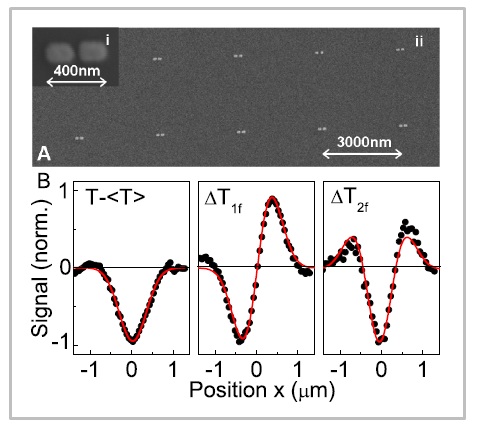
Abstract
Spatial modulation microscopy is a technique originally developed for quantitative spectroscopy
of individual nano-objects. Here, a parallel implementation of the spatial modulation microscopy
technique is demonstrated based on a line detector capable of demodulation at kHz frequencies.
The capabilities of the imaging system are shown using an array of plasmonic nanoantennas and
dendritic cells incubated with gold nanoparticles.
For citations:
N. Fairbairn, R. A. Light, R. Carter, R. Fernandes, A. G. Kanaras, T. J. Elliott, M. G. Somekh, M. C. Pitter, and O. L. Muskens
“Spatial Modulation Microscopy for Real-Time Imaging of Plasmonic Nanoparticles
and Cells”
Optics Letters 2012, 37, (15), 3015–3017 http://arxiv.org/pdf/1203.5966v1.pdf
High Optical Nonlinearity of Nematic Liquid Crystals Doped with Gold Nanoparticles
Journal of Physical Chemistry C 2012, 116 (23) 12934-12939
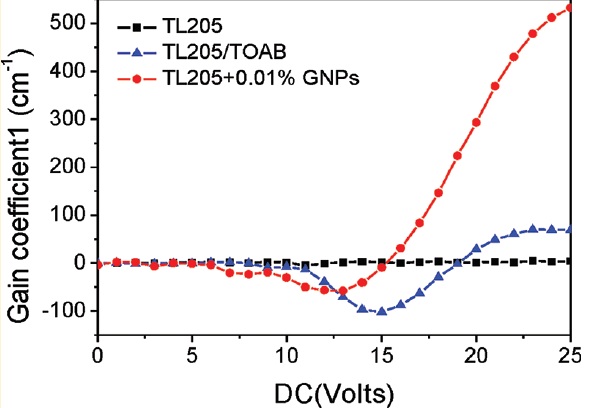
Abstract
Tetraoctylammonium bromide (TOAB)-coated gold nano-particles dispersed in nematic liquid crystals
lead to an enhancement of the nonlinear index coefficient, (n2). A small amount of particles is sufficient
to increase n2 and two-beam coupling gain by more than an order of magnitude while maintaining high
optical quality and the ability of the suspensions to withstand strong applied electric fields.
However, TOAB plays a crucial role in increasing the pretilt angle and reducing the anchoring
strength, which leads to a stronger modulation of both the reorientation and the refractive index
of liquid crystal suspensions.
For citations:
Podoliak, N.; Bartczak,D.; Buchnev, O. Kanaras, A. G.; Kaczmarek, M.
“High Optical Nonlinearity of Nematic Liquid Crystals Doped with Gold Nanoparticles”
J. Phys. Chem. C, 2012, 116 (23) 12934-12939 DOI: 10.1021/jp302558c
Formation and Plasmonic Response of Self-Assembled Layers of Colloidal Gold Nanorods and Branched Gold Nanoparticles
Langmuir 2012, 28 (24), 8874–8880
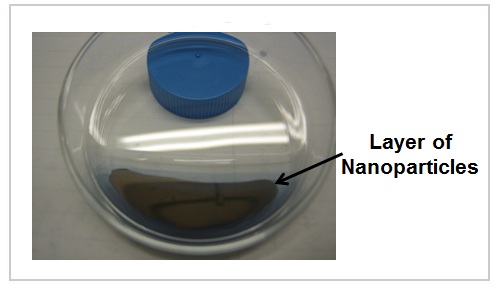
Abstract
The plasmonic properties of self-assembled layers of rod- and branched-shaped gold nanoparticles were
investigated using optical techniques. Nanoparticles were synthesized by a surfactant-guided, seed-mediated
growth method. The layers were obtained by gradual assembly of nanoparticles at the interface between a polar
and a nonpolar solvent and were transferred to a glass slide. Polarization and angle-dependent extinction
measurements showed that the layers made of gold nanorods were governed by an effective medium response.
The response of the layers made by branched gold particles was characterized by random light scattering.
Microscopic mapping of the spatial mode structure demonstrates a uniform optical response of the nanoparticle
layers down to a submicrometer length scale.
For citations:
Schulz, K. M.; Abb, S.; Fernandes, R.; Abb, M.; Kanaras*, A. G.; Muskens*, O. L.
“Formation and Plasmonic Response of Self-Assembled Layers of Colloidal Gold Nanorods and Branched Gold Nanoparticles”
Langmuir, 2012, 28 (24), 8874–8880 DOI: 10.1021/la300199j
Interactions of Human Endothelial Cells with Gold Nanoparticles of Different Morphologies
Small 2012, 8(1), 122-130
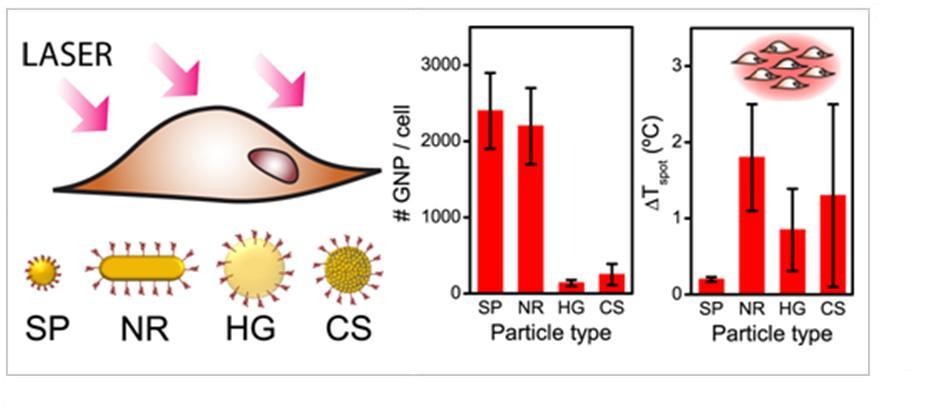
Abstract
The interactions between noncancerous, primary endothelial cells and gold nanoparticles
with different morphologies but of the same ligand capping are presented. Cell viability studies
show that all the types of gold particles are non-cytotoxic. The number of particles taken up by
the cells, differs depending on particle morphology. The above results are employed to discuss
nanoparticle laser hyperthermia. We find that collective heating effects deriving from several
cells loaded with nanoparticles must be included to explain the observed viability of the endothelial cells.
For citations:
Bartczak, D.; Muskens, O. L.; Nitti, S.; Millar T. M..;Sanchez-Elsner T.;Kanaras* A. G.
“Interactions of Human Endothelial Cells with Gold Nanoparticles of Different Morphologies”
Small, 2012, 8(1), 122-130 DOI: 10.1002/smll.201101422
Preparation of Peptide Functionalized Gold Nanoparticles Using One Pot EDC/sulfo-NHS Coupling
Langmuir 2011, 27 (16), 10119–10123
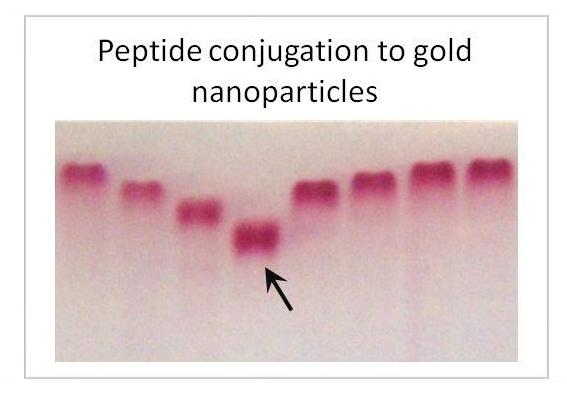
Abstract
Although carbodiimides and succinimides are broadly employed for the formation of amide bonds
(i.e. in aminoacid coupling), their use in the coupling of peptides to water-soluble carboxylic
terminated colloidal gold nanoparticles remains challenging. In this paper, we present an
optimization study for the successful coupling of the KPQPRPLS peptideto spherical and rod-like
colloidal gold nanoparticles. We show that the concentration, reaction time and the chemical
environment are all critical to achieve the formation of robust, peptide-coated colloidal
nanoparticles. Agarose gel electrophoresis was used for the characterization of conjugates.
For citations:
Bartczak, D.; Kanaras* A. G.
“Preparation of Peptide Functionalized Gold Nanoparticles Using One Pot EDC/sulfo-NHS Coupling”
Langmuir, 2011, 27 (16), 10119–10123 DOI: 10.1021/la2022177
Chemically-induced self-assembly of spherical and anisotropic inorganic nanocrystals (Highlighted as 'hot' article)
Journal of Materials Chemistry 2011, 21 (42), 16694 - 16703
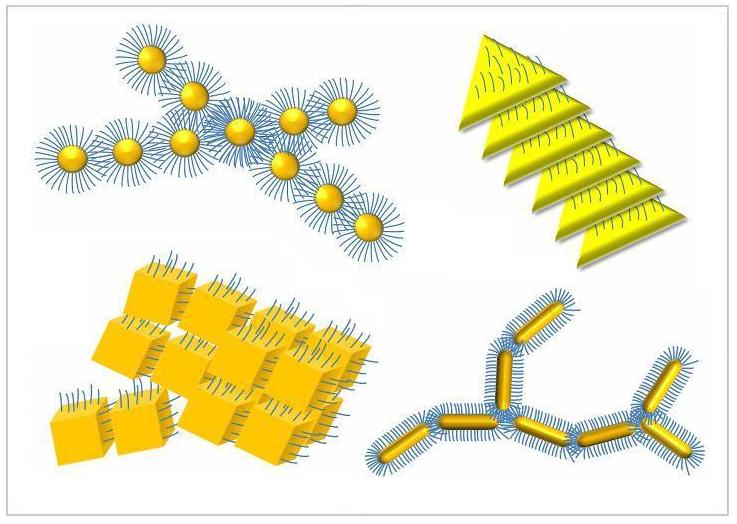
Abstract
The self-assembly of inorganic nanoparticles is a research area of great interest aiming at the fabrication
of unique mesostructured materials with intrinsic properties. Although many assembly strategies have been reported
over the years, chemically induced self-assembly remains one of the dominant approaches to achieve a high level
of nanoparticle organization. In this feature article we review the latest developments in assembly driven
by the active manipulation of nanoparticle surface.
For citations:
Baranov, D.; Manna, L.; Kanaras* A. G.
“Chemically-induced self-assembly of spherical and anisotropic inorganic nanocrystals”
J. Mater. Chem., 2011, 21 (42), 16694 - 16703 DOI: 10.1039/c1jm11599e
Laser-Induced Damage and Recovery of Plasmonically Targeted Human Endothelial Cells
NanoLett. 2011, 11 (3), 1358–1363
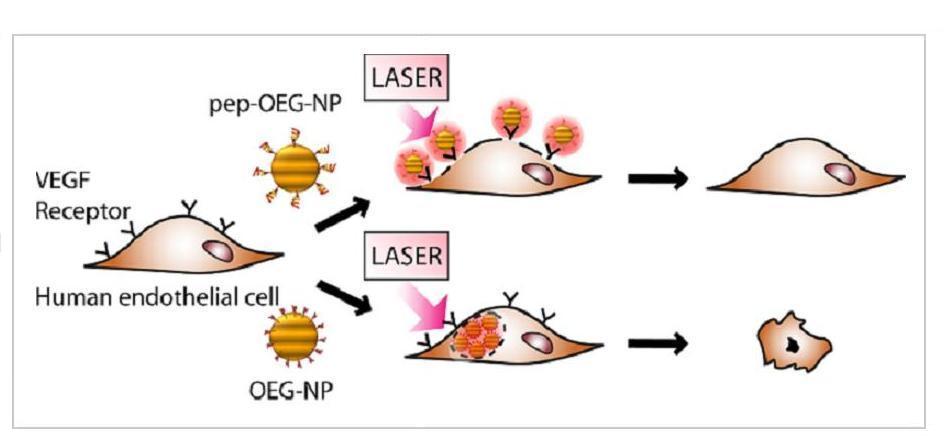
Abstract
Laser-induced techniques that employ the surface plasmon resonances of nanoparticles
have recently been introduced as an effective therapeutic tool for destroying tumor cells.
Here, we adopt a low-intensity laser-induced technique to manipulate the damage and repair
of a vital category of noncancerous cells, human endothelial cells. Endothelial cells
construct the interior of blood vessels and play a pivotal role in angiogenesis.
The degree of damage and repair of the cells is shown to be influenced by laser illumination
in the presence of gold nanoparticles of different morphologies, which either target
the cellular membrane or are endocytosed.A pronounced influence of the plasmonic
nanoparticle laser treatment on the expression of critical angiogenic genes is shown.
Our results show that plasmon-mediated mild laser treatment, combined with specific
targeting of cellular membranes, enables new routes for controlling cell permeability
and gene regulation in endothelial cells.
For citations:
Bartczak, D.; Muskens, O. L.;Millar T.;Sanchez-Elsner T.;Kanaras* A. G.
“Laser-Induced Damage and Recovery of Plasmonically Targeted Human Endothelial Cells”
NanoLett, 2011, 11 (3), 1358–1363 doi:10.1021/nl104528s
Receptor-Mediated Interactions between Colloidal Gold Nanoparticles and Human Umbilical Vein Endothelial Cells
Small 2011, 7, No. 3, 388–394.

Abstract
A new strategy to manipulate cell operations is demonstrated based upon
membrane-receptor specific interactions between colloidal peptide-capped gold nanoparticles
and human umbilical vein endothelial cells. It is shown that colloidal gold nanoparticles of
similar charge and size but capped with different peptide sequences can deliberately
trigger specific cell functions related to the important biological process of blood
vessel growth known as angiogenesis. We achieved the specific binding of the peptide-capped
particles to two endothelial expressed receptors (VEGFR-1, NRP-1) which control angiogenesis,
imaged the cellular fate of the functional nanoparticles and monitored the influence of the
different peptide-coated nanoparticles on the gene expression profile of hypoxia related
and angiogenic genes. Our findings open up new avenues towards the deliberate biological
control of cellular functions using strategically designed nanoparticles.
For citations:
Bartczak D.; Sanchez-Elsner T.; Louafi F., Millar T.; Kanaras* A. G.
“Receptor-mediated interactions between colloidal gold nanoparticles and human umbilical vein endothelial cells”
Small, 2011, 7, No. 3, 388–394, doi:10.1002/smll.201001816
Ligand-mediated self-assembly of polymer-enveloped gold nanoparticle chains and networks
Chem. Commun. 2010, 46, 7602
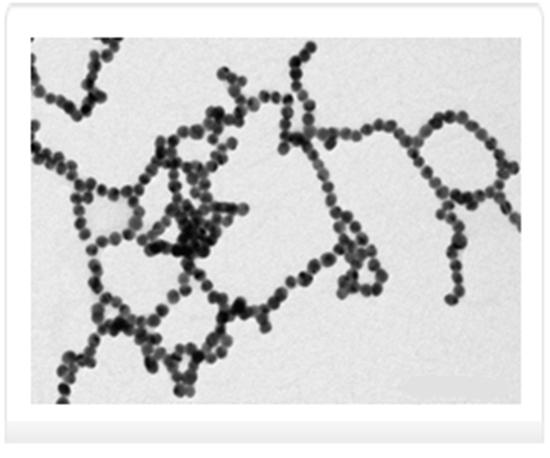
Abstract
We demonstrate a universal approach to assemble gold nanoparticles (AuNPs) into
ordered robust nanostructures. Colloidal AuNPs are partially coated by thiol-containing
ligands and then destabilised into anisotropic superstructures. In situ polymerization
of the surface attached ligands produces enveloped nanoparticle networks with retained
nanoplasmonic properties and enhanced stability.
For citations:
Fernandes R.F.; Dujardin E.; Li M.; Mann S.;* Kanaras A.G. *
“Ligand-mediated self –assembly of polymer-enveloped gold nanoparticles chains and networks”
ChemCommun. 2010, (46), 7602-7604, doi:10.1039/C0CC03033C
Controlling the three-dimensional morphology of nanocrystals
CrystEngComm, 2010, 12 (12), 4312 - 4316
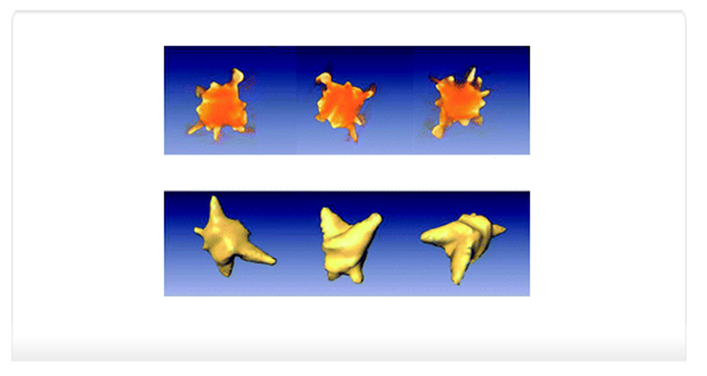
Abstract
We successfully demonstrate the morphological manipulation of complex three-dimensional gold
nanocrystals. The control upon the nanoparticle crystal structure was achieved by the discovery of
a new crystal growth kinetics regime where the number and length of arms as well as the nanocrystal
size can be altered to produce a multitude of architectures. The synergetic relationship between
chemical reaction components and possible mechanistic pathways is discussed. TEM tomography was
employed to characterize the three-dimensional structure of the complex morphologies.
For citations:
Day, H.A; Bartczak, D.; Fairbairn, N.;, Mcguire, E; Ardakani, M.; Porter, A.E.; Kanaras* A. G.
“Controlling the three-dimensional morphology of nanocrystals”
CrystEngComm, 2010, 12, 4312-4316 doi:10.1039/C0CE00264J
Programmed Assembly of Peptide-Functionalized Gold Nanoparticles on DNA Templates
Langmuir 2010, 26 (17),13760–13762
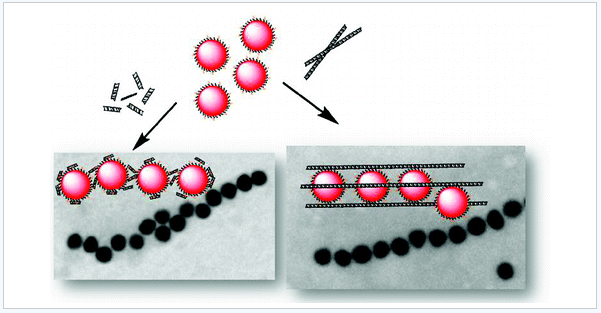
Abstract
We present a novel nanoparticle building block system based on the interactions between short synthetic oligonucleotides
and peptides. Gold nanoparticles coated with DNA-binding peptides can be attached to self-organized oligonucleotide templates
to formulate well-ordered structures of nanoparticles. By regulating the amount of DNA-binding peptide attached to the
nanoparticle surface and using specifically designed oligonucleotides, the nanoparticle assembly can be controlled to
form dimers, trimers, and adjustable-length nanoparticle chains as well as more complex structures.
For citations:
Coomber, D.; Bartczak, D.; Gerrard, S.R.; Tyas,S.; Kanaras*, A.G; Stulz*, E.
“Programmed assembly of peptide-functionalized gold nanoparticles on DNA templates”
Langmuir 2010, 26 (17),13760–13762 doi:10.1021/la1023554
Enzymatic Activity of Lipase-Nanoparticle Conjugates and the Digestion of Lipid Liquid Crystalline Assemblies
Langmuir 2010, 26 (16),13590-13599
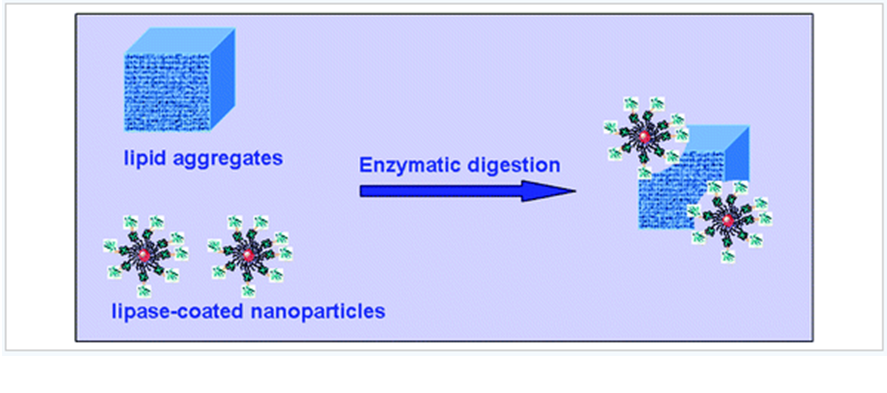
Abstract
Variants of lipase were attached to gold nanoparticles (NPs) and their enzymatic activity was studied.
The two bioengineered lipase variants have been prepared with biotin groups attached to different residues
on the protein outer surface. The biotinylation was evidenced by denaturing polyacrylamide gel electrophoresis
and quantified by the ([2-(4'-hydroxyazobenzene)]benzoic acid spectrophotometric test. NPs of 14 ± 1 nm diameter
coated with thiolated-polyethylene glycol ligands containing controlled proportions of biotin moieties have been
prepared and characterized by transmission electron microscopy, UV-vis spectroscopy, small angle neutron scattering,
and elemental analysis. These biotin-functionalized NPs were conjugated to lipase using streptavidin as a linker molecule.
Enzyme activity assays on the lipase-nanoparticle conjugates show that the lipase loading and activity of the NPs
can be controlled by varying the percentage of biotin groups in the particle protecting coat. The lipase-NP
conjugates prepared using one variant display higher activity than those prepared using the other variant,
demonstrating orientation-dependent enzyme activity. Cryogenic transmission electron microscopy was used
to visualize the enzymatic activity of lipase-NP on well-defined lipid substrates. It was found that lipase-coated
NPs are able to digest the substrates in a different manner in comparison to the free lipase.
For citations:
Brennan J. L.; Kanaras A. G.; Nativo, P.; Tshikhudo T. R.; Rees C.; Fernandez L. C.;
Dirvianskyte N.; Razumas V.; Skjøt, M.; Svendsen A.; Jørgensen C. L.; Brust M.;
Schweins R.; Zackrisson M.; Nylander T.; Barauskas J.
”Enzymatic Activity of Lipase-Nanoparticle Conjugates and the Digestion of Lipid Liquid
Crystalline Assemblies Gold Nanoparticles.”
Langmuir 2010, 26 (16),13590-13599 doi:10.1021/la1018604
Diacetylene-Containing Ligand As a New Capping Agent for the Preparation of Water-Soluble Colloidal Nanoparticles of Remarkable Stability
Langmuir 2010, 26 (10), 7072–7077
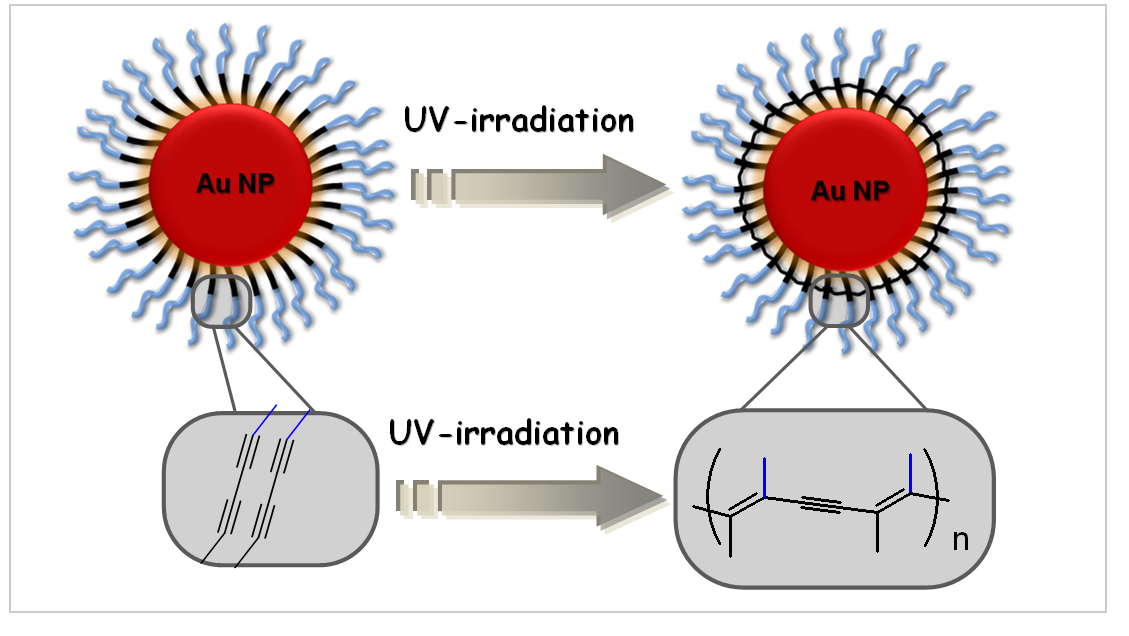
Abstract
A new type of strategically designed functional ligands was used to cap gold nanocrystals and form robust colloidal nanoparticles,
resistant to pH changes, temperature, and ionic strength variations
as well as ligand-exchange reactions.
The nanoparticles are coated with ligands that polymerize upon UV-irradiation, consequently embedding the particles in a stable organic
shell. The ligand consists of
an anchoring thiol group, which binds directly to the nanocrystal surface and two units, one hydrophobic
and one hydrophilic. The hydrophobic alkyl unit contains a diacetylene group, which undergoes a
1,4-topochemical polymerization leading to a poly(enyne) structure during UV-irradiation. The hydrophilic unit contains an oligo-ethylene glycol chain, which ensures water solubility,
and a terminal carboxylic
group. Derived particles were characterized by transmission electron microscopy, surface enhanced Raman spectroscopy,
and visible spectroscopy. Their stability was investigated and compared to particles
capped with nonpolymerized ligands.
For citations:
Bartczak D.; Kanaras A. G.*
“Diacetylene-Containing Ligand As a New Capping Agent for the Preparation of Water-Soluble Colloidal Nanoparticles of Remarkable Stability”
Langmuir 2010, 26 (10), 7072–7077 doi:10.1021/la9044013
TiO2 nanoparticles as a soft X-ray molecular probe
Chem Commun., 2008, 2471–2473
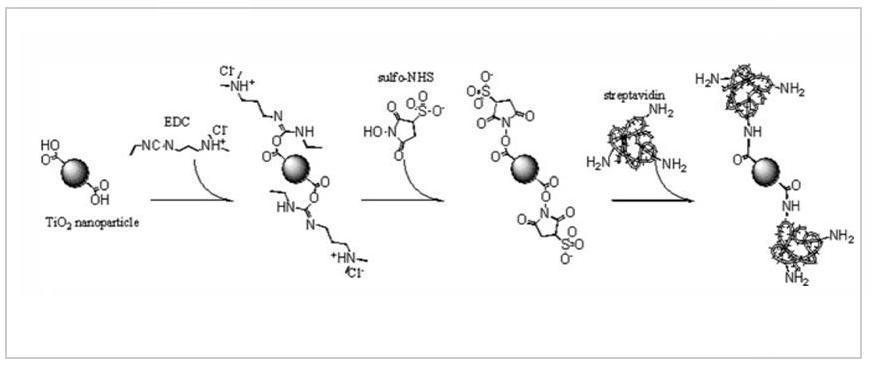
Abstract
This communication reports the development of a TiO2–streptavidin
nanoconjugate as a new biological label for X-ray bioimaging
applications; this new probe, used in conjunction with
the nanogold probe, will make it possible to obtain quantitative,
high-resolution information about
the location of proteins using
X-ray microscopy.
For citations:
Ashcroft J. M.; Gu W.; Zhang T.; Hughes S. M.; Hartman K. B.; Hofmann C.;Kanaras A. G.;
Kilcoyne D. A.;Le Gros M.; Yin Y.; Alivisatos A. P; Larabell C. A;
“TiO2 Nanoparticles as a Soft X-ray Molecular Probe”
ChemCommun. 2008, (21), 2471-2473 doi: 10.1039/B801392F
Shaping Supramolecular Nanofibers with Nanoparticles Forming
Complementary Hydrogen Bonds
Angew. Chem. Int. Ed. 2008, 47, 1861 –1865
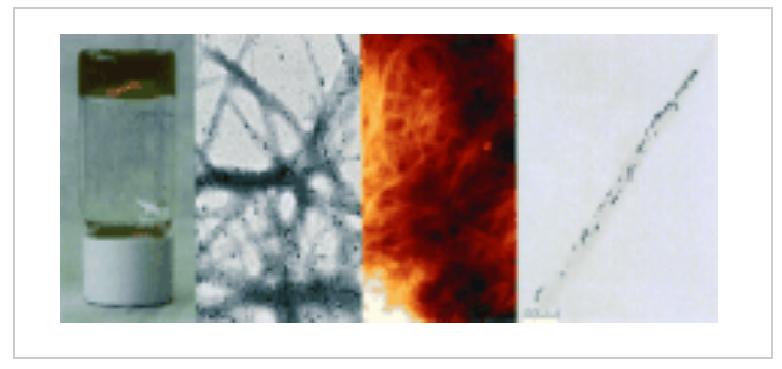
Abstract
Functionalized gold nanoparticles with complementary H-bonding groups can control the secondary structure of xerogel fibers formed
by a molecular conductor thanks to their incorporation into the nanowires, which show metal-like conductivity once doped without the
need for annealing. The picture shows a photograph of the xerogel, TEM images of Au particles in the gel and a single fiber, and
an AFM image revealing the texture of the gel.
For citations:
Puigmartí-Luis J.; Pérez del Pino A.; Laukhina E.; Laukhin V.; Rovira C.; Vidal-Gancedo J.; Kanaras A. G.;
Nichols R. J.; Brust M.; Amabilino D. B.;
“Shaping supramolecular nanoribers with nanoparticles forming complementary hydrogen bonds”
Angew. Chem. Int. Ed., 2008, 47 (10), 1861-1865 doi:10.1002/anie.200704864, Angew. Chem. 2008, 120 (10), 1887–1891 doi:10.1002/ange.200704864
Site-Specific Ligation of DNA-Modified Gold Nanoparticles Activated by the Restriction Enzyme StyI
small 2007, 3, No. 1, 67 – 70

Abstract
A new method of enzymatically controlled nanoparticle assembly has been developed
by using a restriction enzyme that recognizes an asymmetric DNA site. The site-selective
binding of gold nanoparticles to each other and to surfaces has been demonstrated
in proof-of-principle experiments.
For citations:
Kanaras A. G.; Wang Z.; Hussain I.; Brust M.; Cosstick R.; Bates A. D.;
“ Site-Specific Ligation of DNA-Modified Gold Nanoparticles Activated by the Restriction Enzyme StyI”
Small 2007, 3 (1), 67-70 doi:10.1002/smll.200600464
Enzymatic Disassembly of DNA–Gold Nanostructures
small 2007, 3, No. 4, 590 – 594
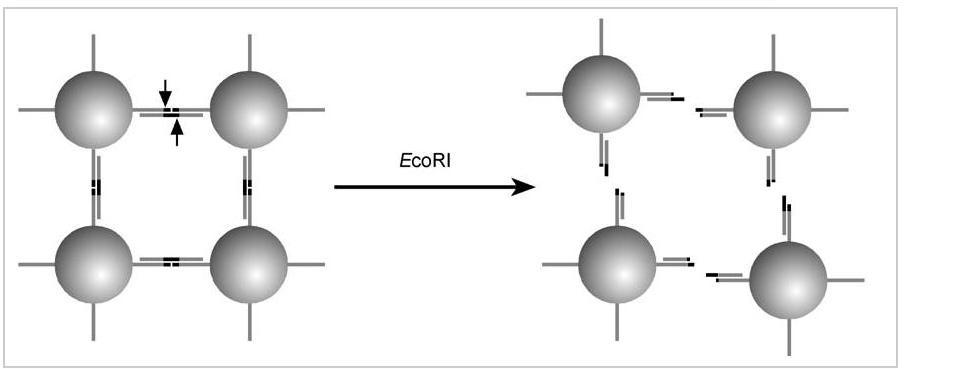
Abstract
The efficient digestion of nanoparticle assemblies connected by DNA linkers is
demonstrated using a number of complementary methods. The efficiency of digestion
is dependent on the design of the DNA linker. The ability to manipulate DNA
enzymatically is important in the development of hierarchical chemical methods of
nanoscale assembly.
For citations:
Kanaras A. G.; Wang Z.; Brust M.; Cosstick R.; Bates A. D.;
“Enzymatic Disassembly of DNA/Gold Nanostructures”
Small 2007, 3 (4), 590-594 doi:10.1002/smll.200600494
Hybrid Solar Cells with Prescribed
Nanoscale Morphologies Based on
Hyperbranched Semiconductor
Nanocrystals
Nano Lett., Vol. 7, No. 2, 2007, 409-414
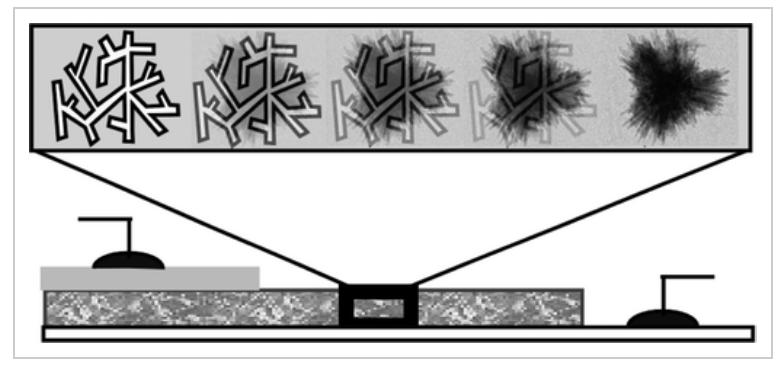
Abstract
In recent years, the search to develop large-area solar cells at low cost has led to research on photovoltaic (PV) systems based on
nanocomposites containing conjugated polymers. These composite films can be synthesized and processed at lower costs and with
greater versatility than the solid state inorganic semiconductors that comprise today’s solar cells. However, the best nanocomposite
solar cells are based on a complex architecture, consisting of a fine blend of interpenetrating and percolating donor and acceptor materials.
Cell performance is strongly dependent on blend morphology, and solution-based fabrication techniques often result in uncontrolled and
irreproducible blends, whose composite morphologies are difficult to characterize accurately. Here we incorporate three-dimensional
hyperbranched colloidal semiconductor nanocrystals in solution-processed hybrid organic-inorganic solar cells, yielding reproducible and
controlled nanoscale morphology.
For citations:
Gur I.; Fromer N.; Chen C.P.; Kanaras A. G.; Alivisatos A.P.;
“Hybrid solar cells with prescribed nanoscale morphologies based on hyperbranched semiconductor nanocrystals”
Nano Lett. 2007, 7 (2), 409-414 doi:10.1021/nl062660t
Controlled Synthesis of Hyperbranched
Inorganic Nanocrystals with Rich
Three-Dimensional Structures
Nano Lett., Vol. 5, No. 11, 2005, 2164-2167
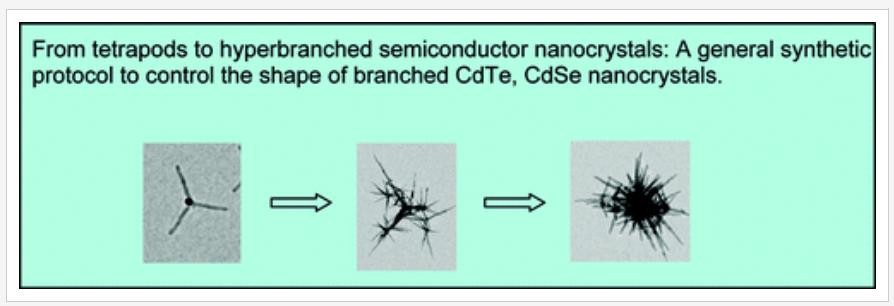
Abstract
Controlled synthesis of hyperbranched CdTe and CdSe semiconductor nanocrystals is presented. The length of the arms and the degree of
branching
could be controlled independently by varying the amount and kind of organic surfactant. The three-dimensional structure of these
nanocrystals has been characterized with TEM tomography.
For citations:
Kanaras A. G.; Sönnichsen C.; Liu H.; Alivisatos A.P.;
“ Controlled Synthesis of Hyperbranched Inorganic Nanocrystals with Rich Three-Dimensional Structures’
Nano Lett., 2005, 5 (11), 2164-2167 doi:10.1021/nl0518728
Enzymatic DNA processing on gold nanoparticles
J. Mater. Chem., 2004, 14, 578–580
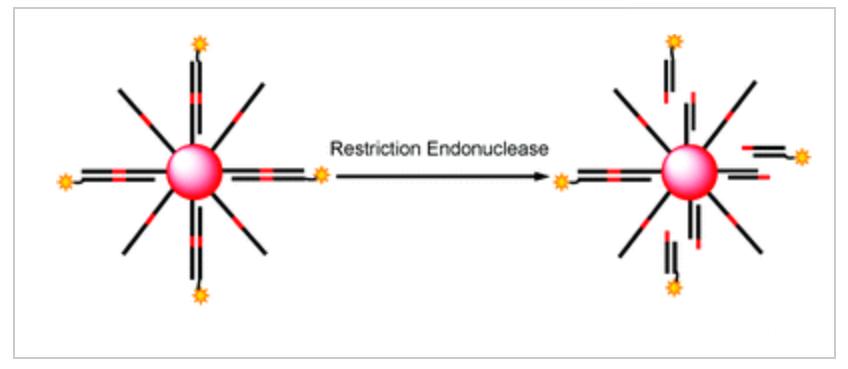
Abstract
Double stranded DNA immobilised on gold nanoparticles
is amenable to enzymatic cleavage by a range of restriction
endonucleases
and the efficiency of the cleavage can be
quantified using fluorescence spectroscopy.
For citations:
Wang Z.; Kanaras A. G.; Bates A. D.; Cosstick R.; Brust M.;
“Enzymatic DNA Processing on Gold Nanoparticles.”
J. Mater. Chem., 2004, 14 (4), 578-580 doi:10.1039/B314328G
Towards Multistep Nanostructure Synthesis:
Programmed Enzymatic Self-Assembly of DNA/
Gold Systems
Angew. Chem. Int. Ed. 2003, 42, No. 2, 191-194

Abstract
Enzyme-dependent assembly of DNA/gold nanostructures is achieved using DNA-capped gold colloids
and DNA processing enzymes. Particle-bound DNA double strands
are cleaved at designated sites by a restriction endonuclease (see picture).
In a subsequent step the particles are linked to each other
through these
activated sites by a DNA ligase. This new strategy enables the multistep synthesis of nanostructures.
For citations:
Kanaras A. G.; Wang Z.; Bates A. D.; Cosstick R.; Brust M.;
“Towards multi-step nanostructure synthesis: programmed enzymatic self-assembly of DNA/gold systems.”
Angew. Chem. Int. Ed., 2003, 42 (2), 191-194 doi: 10.1002/anie.200390075, Angew. Chem. 2003, 115 (2), 201-204 doi: 10.1002/ange.200390043
Thioalkylated tetraethylene glycol: a new ligand for water soluble
monolayer protected gold clusters
Chem. Commun., 2002, 2294–2295
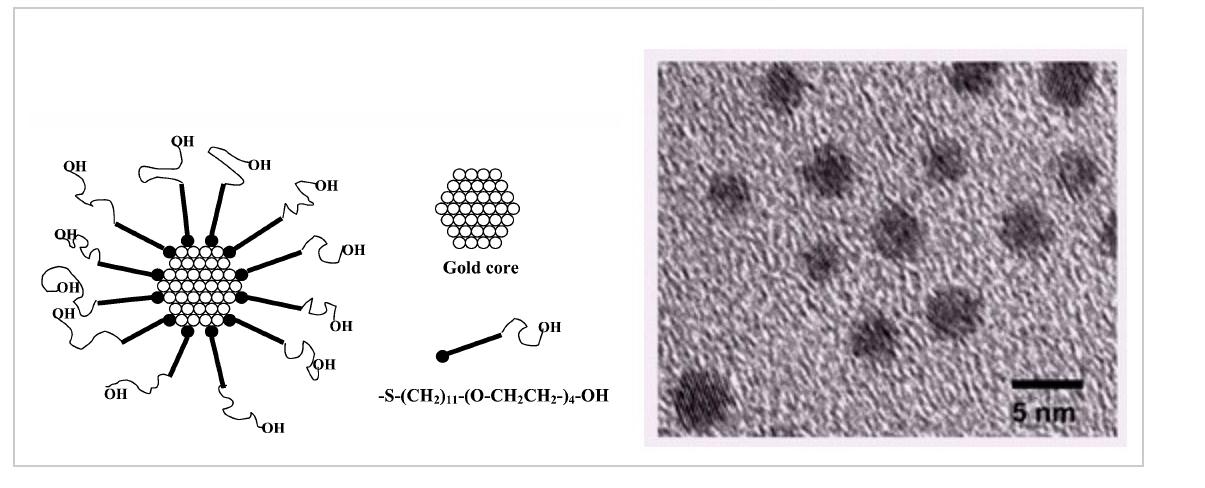
Abstract
Ligand-stabilised, water-soluble gold nanoparticles of two
different size ranges (2–4 and 5–8 nm) are readily prepared
using monohydroxy (1-mercaptoundec-11-yl) tetraethylene
glycol as a novel capping agent. These nanoparticles are as
stable as alkylthiol-capped monolayer protected clusters
(MPCs) and do not aggregate from aqueous solution under a
wide range of
stringent conditions. It is expected that this
new material will be useful for a number of bio-analytical
applications.
For citations:
Kanaras A. G.; Kamounah F. S.; Schaumburg K.; Kiely C.; Brust M.;
“Thioalkylated tetraethylene glycol: a new ligand for water soluble monolayer protected gold clusters.”
Chem. Comm. 2002, 20, 2294-2295 doi:10.1039/B207838B
|

